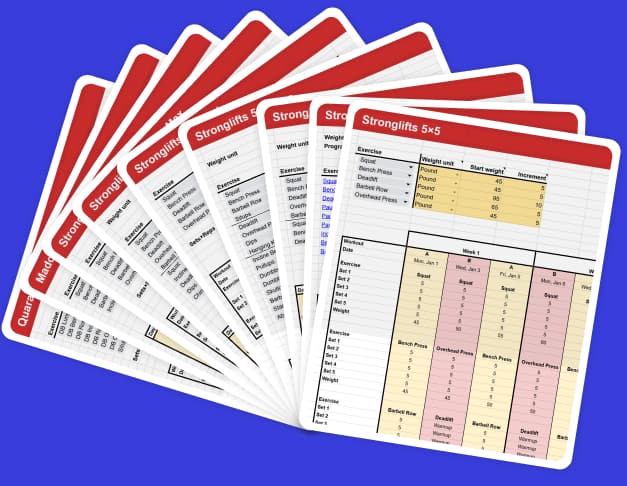Switch to 5×5 top/back-off sets once you start failing reps on Stronglifts 5×5. This helps you overcome plateaus on 5×5 straight sets.
- 5×5 straight sets is lifting the same weight for five sets of five reps. This is recommended for new, returning or weaker lifters.
- 5×5 top/back-off sets is doing one heavy set of five reps followed by four lighter sets of five. This is recommended once you’re stronger.
In this guide I’ll show you the benefits of switching to top/back-off sets once you’re struggling to progress on Stronglifts 5×5 using straight sets.
Let’s start with the difference between 5×5 straight sets and top/back-off sets.
Contents
- Straight sets explained
- Top/back-off sets explained
- Getting started with top/back-off sets
- Frequently asked questions
- Are top/back-off sets the same as drop sets?
- How much weight should you use for the back-off sets?
- Should you decrease the weight on every set?
- Can you start Stronglifts 5×5 with top/back-off sets instead of straight sets?
- What if you want to switch back to 5×5 straight sets?
- Which is best? Straight or top/back-off sets?
- Why doesn’t the Stronglifts app always increase the weight of the back-off sets?
- References
Join the Stronglifts community to get free access to all the spreadsheets for every Stronglifts program. You’ll also get 15% off Stronglifts Pro, and daily email tips. Enter your email below to sign up today for free.
Straight sets explained
What are straight sets
5×5 straight sets means using the same weight on all five sets. On Stronglifts 5×5 you do 5 straight sets of 5 on the Squat, Bench Press, Overhead Press and Barbell Row. On Deadlifts you don’t do 5×5 straight sets because you’re already doing 5×5 Squats 3x/week. You do 1×5 Deadlifts instead.
Say you Squat 200lb for 5×5 straight sets. Warmup by doing 2×5 with the empty bar. Add weight and do gradually heavier sets of five until you reach your work weight of 200lb for 5×5. Like this…
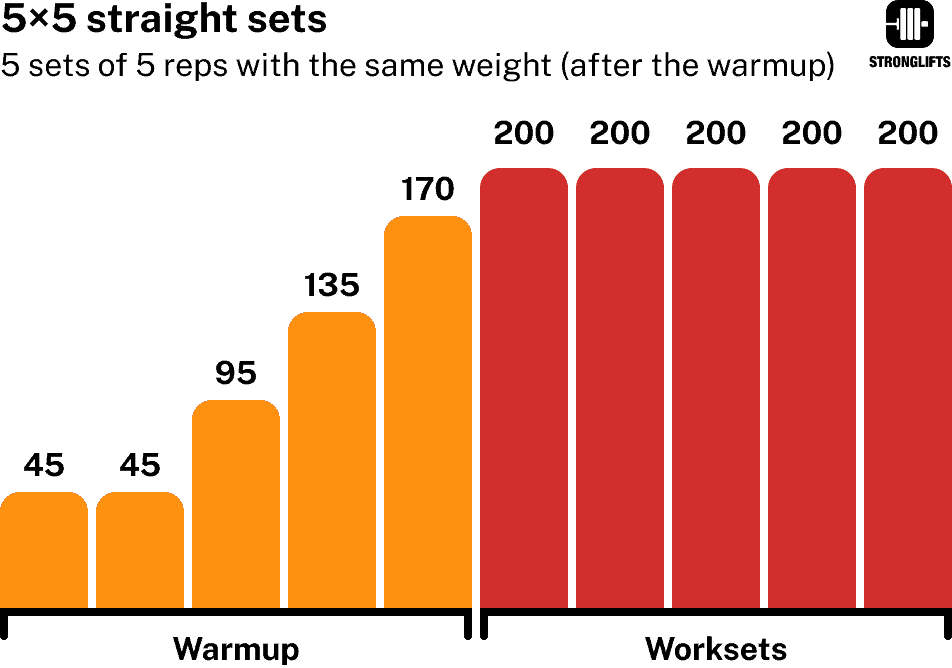
Between your 5×5 straight sets you rest for about 2-3 minutes. Hard sets may need 5min rest periods to complete the full five reps without failure.
Note that the Stronglifts app calculates the above warmup sequence for you. Just go start workout then tap warmup at the top.
Let’s go over the pros and cons of straight sets.
Why Stronglifts 5×5 uses straight sets
There are two reasons why Stronglifts 5×5 uses 5×5 straight sets during the first weeks of the program…
- Straight sets prevent you from going too heavy and training to failure when you start lifting weights.
- Straight sets keep the program simple by saving you math. You don’t have to adjust or calculate the weight for some sets. You simply use the same weight for all five sets. This reduces complexity.
Stronglifts 5×5 is aimed at new, returning and weak lifters. Their priorities are to develop gym consistency, learn proper form on the compound lifts and build confidence with the weights. This sets the foundation for applying progressive overload – adding weight on the bar gradually and consistently.
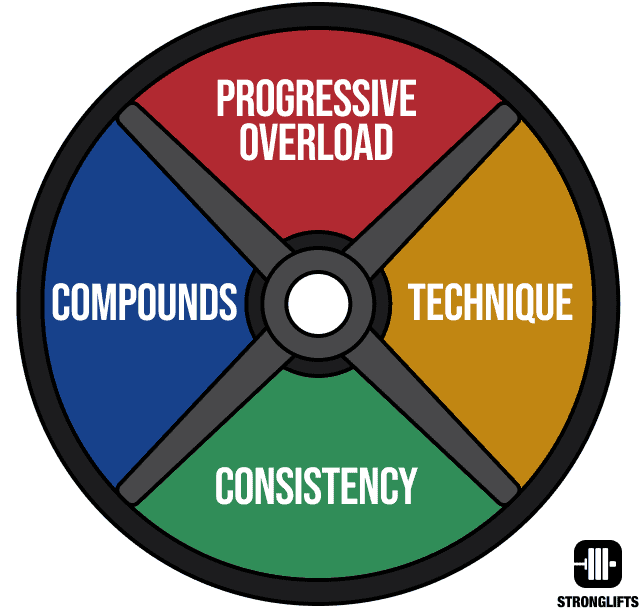
Progressive overload is key to getting results (1, 2). If you don’t lift more weight than six months ago, you won’t look any different. You must add weight on the bar over time to build strength and muscle. Adding weight increases the tension on your muscles. Muscular tension is the main driver of muscle growth (3, 4). We’ve known this for almost 50 years.

The problem is that many people are afraid of going heavy. They don’t realize that lifting weights has a lower risk of injury than sports commonly believed to be safer like running and even swimming (5, 6, 7). You’re more likely to get hurt on your way to the gym than lifting in the gym.
| Gimigliano et al, 2021 | Injuries / 1000 hours |
|---|---|
| Marathon | 65 |
| Soccer | 29.3 – 50.8 |
| Tennis | 54.8 – 56.6 |
| Rugby | 43.2 |
| Triathlon | 17.4 |
| Golf | 8.5 |
| Basketball | 7.97 |
| Wrestling | 5.7 |
| Volleyball | 4.69 |
| Handball | 4.3 |
| Baseball | 3.61 |
| Weightlifting | 2.4 – 3.3 |
Safety is important. But irrational fear will hinder your progress. Many people struggle to build muscle and strength because they don’t add weight on the bar. They don’t apply progressive overload. Yet this is a fundamental principle of strength and muscle building (1). Your program can’t work without.
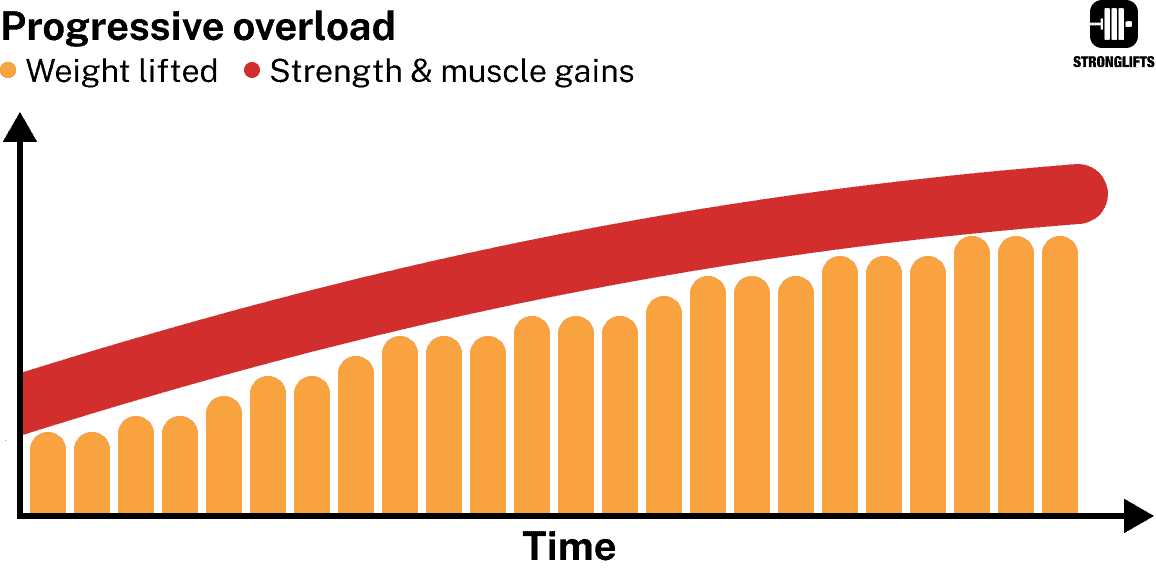
Stronglifts 5×5 builds your confidence with the weights by focusing on proper form and starting with easy weights. 5×5 straight sets force you to use a lighter weight. This prevents you from hitting failure on the first set. Straight sets also keep the program simple by reducing math.
Let me show you how 5×5 straight sets prevent you from training to absolute failure, and why this is important when you start lifting weights.
How hard should 5×5 straight sets be?
Your average RPE for 5×5 straight sets should be 6 to 8.
RPE stands for rate of perceived effort (8, 9). RPE 10 is an all-out effort set. You couldn’t do more than five reps if you tried. Not even if someone held a gun to your head. Think Dorian Yates “blood and guts” high intensity where you train until absolute failure and maybe feel nauseous after.
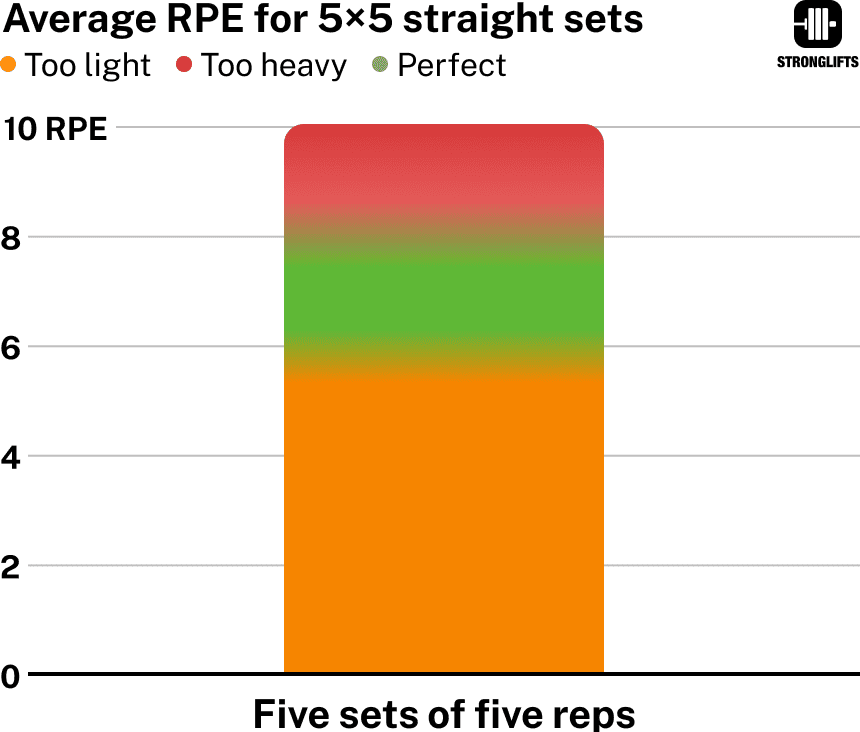
On Stronglifts 5×5 your average RPE for 5×5 straight sets should be 6-8. You should be able to do 4 to 2 more reps per set. You should be able to do 7 to 9 reps on the majority of your sets of five. If one set, usually the last one, is RPE 9 or even 10, that’s fine. But all your sets shouldn’t be RPE 10. Training to failure doesn’t work for 5×5 straight sets as I’m going to show you.
| How many more reps could you have done? | RPE |
|---|---|
| None (max effort) | 10 |
| Maybe 1 | 9.5 |
| Definitely 1 | 9 |
| Maybe 2 | 8.5 |
| Definitely 2 | 8 |
| Maybe 3 | 7.5 |
| Definitely 3 | 7 |
| Maybe 4 | 6.5 |
The RPE chart tells how many reps you can do at different levels of effort. It helps you put the right weight on the bar. My coach Mike Tuchscherer created this chart in 2008 (8, 10). He started coaching me in 2011 and so I’ve been using RPE for 13 years. RPE is now used in scientific studies (9). Let’s look at the weight percentages when doing sets of five reps.
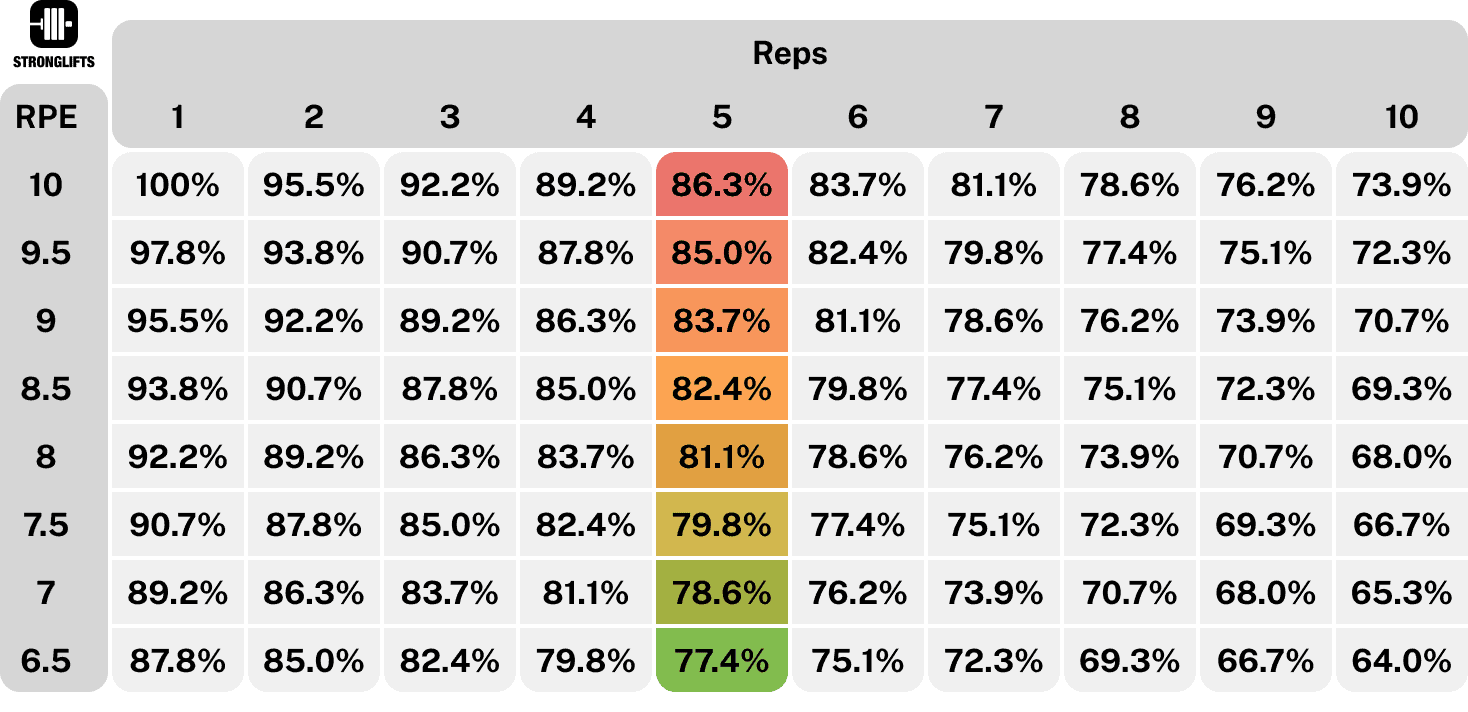
Five reps at RPE 10 is 86.3% of your one rep max (1RM). So if you can lift 200lb for one rep, you can do 200 x 0.863 = 172.6lb for one hard set of five. Some people can do more or less reps at the same percentage (11). But in my coaching experience these numbers are usually accurate.
You cannot lift your five rep max for five sets of five reps (24). You can lift it for one hard set of five at RPE 10. If you try to lift the same weight for four more sets after that, you’ll find that it’s too heavy. You’ll either miss reps, or you’ll have to lower the weight to keep getting five reps per set.
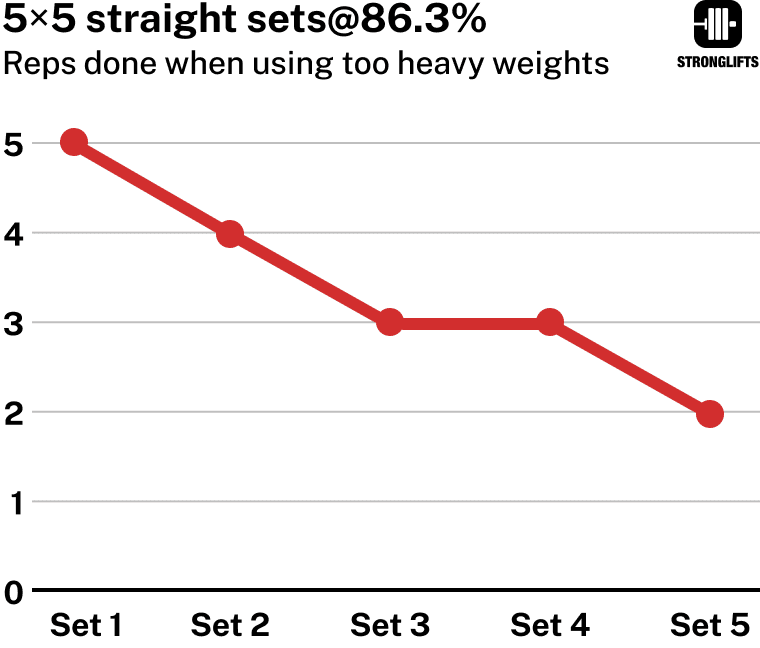
What if you can do 5×5 with your five rep max? Then the weight you lifted wasn’t your five rep max. By definition, your five reps max is the heaviest weight you can lift for one set of five. The weight you can lift for five sets of five will always be lower because each set creates fatigue (12). That fatigue makes it harder to lift your five rep max again and so you miss reps (24).
For 5×5 straight sets, most lifters need to use a weight that’s around 70-80% of their max. If we look at the RPE chart, that’s between 6 and 8 RPE.
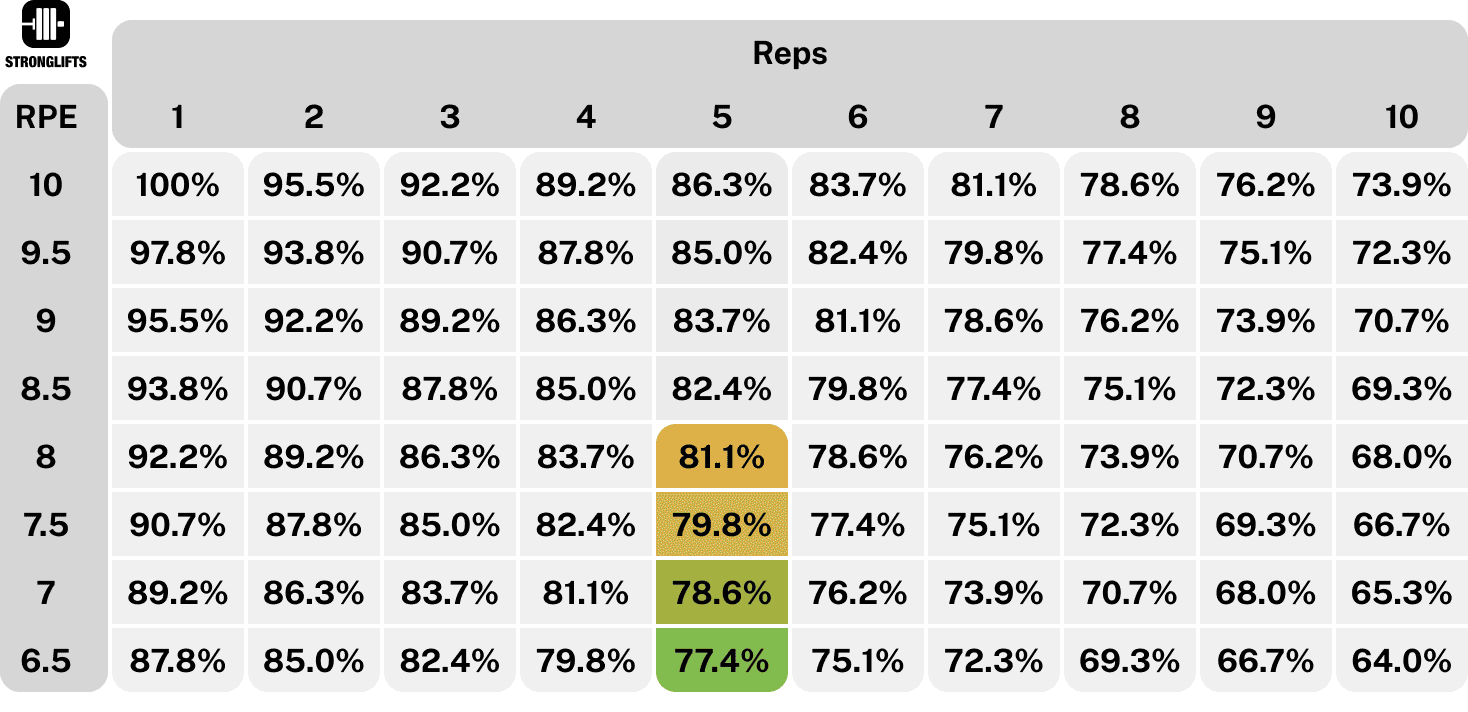
Again, some people can do more reps with 70-80% of their max than others (11). The point here is that you shouldn’t be doing 5×5 straight sets with your five rep max. You shouldn’t be doing 5×5 straight sets at RPE 10. You shouldn’t be lifting to absolute failure from the first set onwards.
New, returning or weaker lifters don’t even need to do 5×5 straight sets with 70-80%. A study by Peterson et al found that beginners can build strength by training with only 60% of their max (13). Their effort-to-benefit is lower. They can progress with lower intensities than experienced lifters.
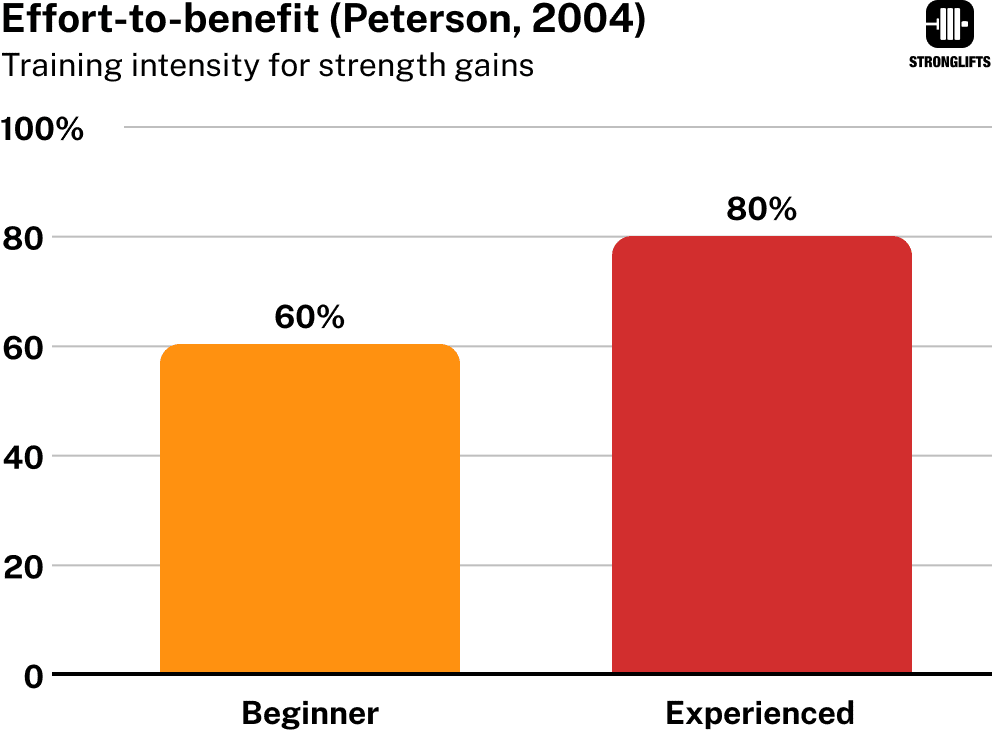
That’s why a good starting weight for your first Stronglifts 5×5 workouts is something you can lift for 10 reps. Say you can Squat 135lb for 10 reps. Lift that for 5×5. Your RPE will be about 5-6. You’ll have 4-5 reps left in the tank after each set. Starting with easy weights has several benefits…
- You don’t start failing reps from the first workouts. You have room to progress. This is more motivating.
- You get less sore. This makes it easier to train the same muscles again two days later so you can improve your form faster.
- You can better focus on proper form because lighter weight is easier to control. Good form matters for adding weight later.
- Your joints and tendons have time to adapt (they need more time than your muscles). This prevents pains from going too hard, too soon.
If you’re struggling to complete five reps on your first set, then the weight is too heavy for 5×5 straight sets. You should not be training to failure on Stronglifts 5×5. Here’s why…
5×5 straight sets vs failure training
People used to training to failure often get confused when they start Stronglifts 5×5. They can’t hit failure like they did on body part routines. They think it’s a bug in the program. It’s not a bug. It’s a feature. We don’t want new, returning, or weaker lifters to train to failure. Here’s why…
#1: Failure training makes it harder to keep proper form
New, returning and weaker lifters lack the muscular strength and endurance to maintain proper form when tired. Their technique breaks down more. This can cause unnecessary anxiety, or worse, result in pain. It hinders the process of learning proper form which is key for adding weight safely.
#2: Failure training is harder to recover from
A study by Morán et al compared 3×10 to failure to 6×5 not to failure (14). Both groups lifted 75% of their max on the Squat and Bench. This means that the 3×10 group trained at RPE 9-10. The 6×5 group trained at RPE <7 (about three reps left in the tank on each set).
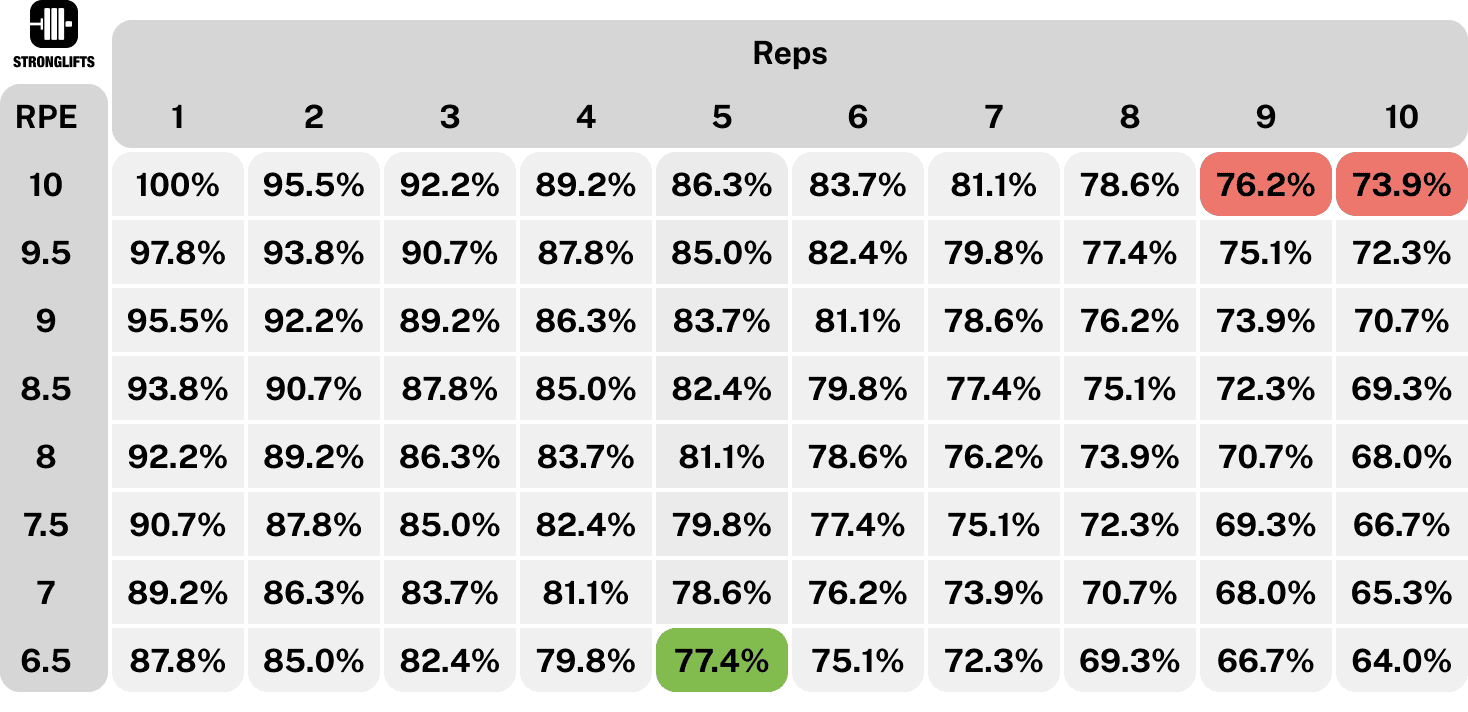
They measured recovery time by testing how fast they could lift the same weight before and after the workout. Recovery was slower for up to 24 to 48 hours post-workout when doing 3×10 to failure. The group that did 6×5 without failure recovered faster than the one that did 3×10 to failure.
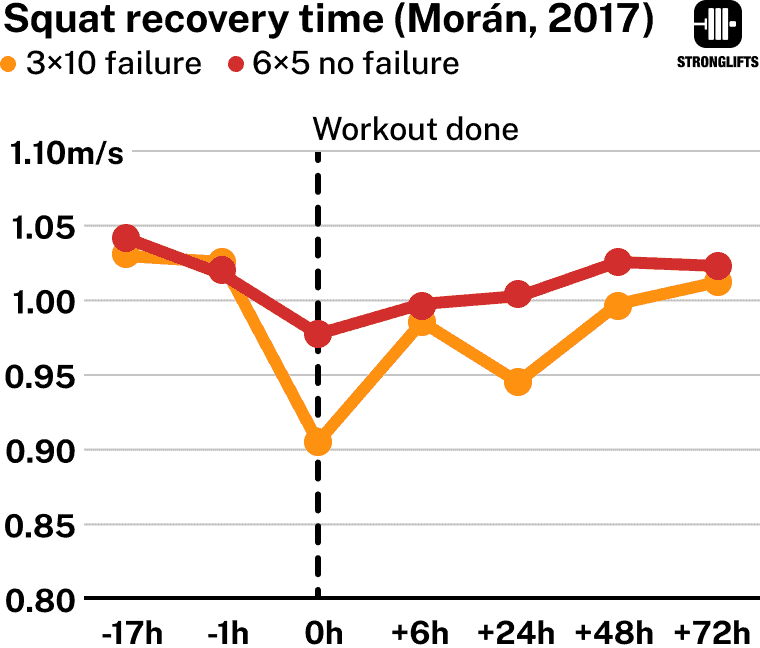
#3: Failure training makes it harder to train movements frequently
Fast recovery within 24-48h isn’t important if you do a body part routine where you Squat 1x/week. You have seven days before you Squat again. That gives your legs plenty of time to recover. The problem is that you only get 12x Squat practice over 12 weeks. Even less if you skip your “leg day”.
Squatting 3x/week on Stronglifts 5×5 gives you 36x practice over the same 12 weeks. You get 3x more practice and so your technique improves faster. This is important for new, returning or weaker lifters who must learn how to Squat as fast as possible so they can start adding weight. The more often you practice a lift, the quicker your technique will improve.
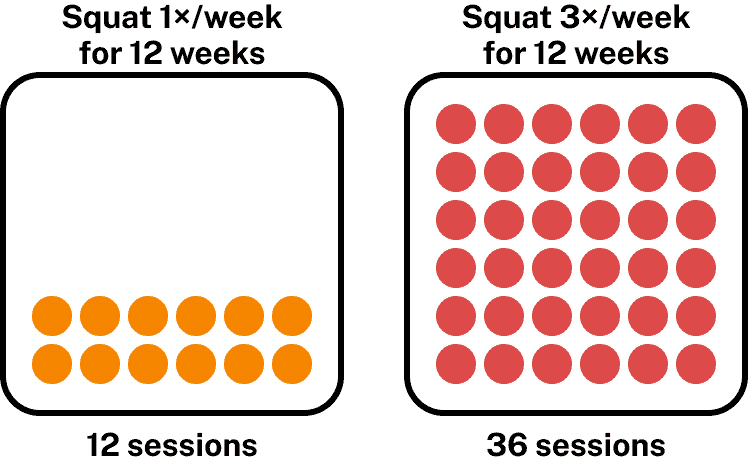
When I did body part split routines 25 years ago, I took every set to failure like Dorian Yates did. My legs were usually sore for five days after the weekly “leg day”. Later I found the 5×5 workout, saw the 3x/week Squats and thought the program was a prank. I didn’t understand how you could Squat 3x/week. I do now – the secret is to not take every set to absolute failure.
#4: Failure training isn’t necessary to build strength and muscle
Contrary to popular belief, training to absolute failure isn’t necessary to build strength and muscle (15, 16, 17). Progressive overload is the main driver of muscle growth – adding weight over time (3, 4). You don’t have to hammer and grind your muscles by training to complete failure to “break them down” so they grow bigger. That causes excess fatigue. It makes it harder to train your muscles more frequently and add weight on the bar consistently.
Some people think starting with lighter weights is a waste of time. It’s not. New lifters can get stronger by training with only 60% of their max (13). Their effort-to-benefit is lower. They can make progress despite doing 5×5 at a lower RPE of only 5-6. While you do need to put in more effort once you get stronger, you don’t need to train super heavy when you start Stronglifts 5×5.

The best reason to start with easy weights is that it develops consistency. Training to failure is uncomfortable which can decrease adherence (18, 19). When I did Squats for the first time 25 years ago, my mentor made me train to absolute failure. I ended up vomiting my lunch in the showers. Somehow I came back for more the next day. Normal people don’t.
Stronglifts 5×5 uses 5×5 straight sets to avoid training to failure. You can’t lift your five rep max for 5×5. You have to pick a lower weight in order to lift it for five sets of five. This is better for new, returning and weak lifters.
Now that we’ve covered the benefits of 5×5 straight sets, let me show you their limitations once you’ve progressed beyond the beginner gains.
Why 5×5 straight sets doesn’t work forever
You cannot add weight 2-3x/week on the same exercise forever by doing 5×5 straight sets. You’ll eventually fail reps and plateau.
When you start lifting weights, most of your initial strength gains are neural (4). Your body gets better at lifting the bar using your existing muscles. The strength gains happen so quickly, you can lift 5lb more next workout without too much extra effort. These are the easy beginner gains.
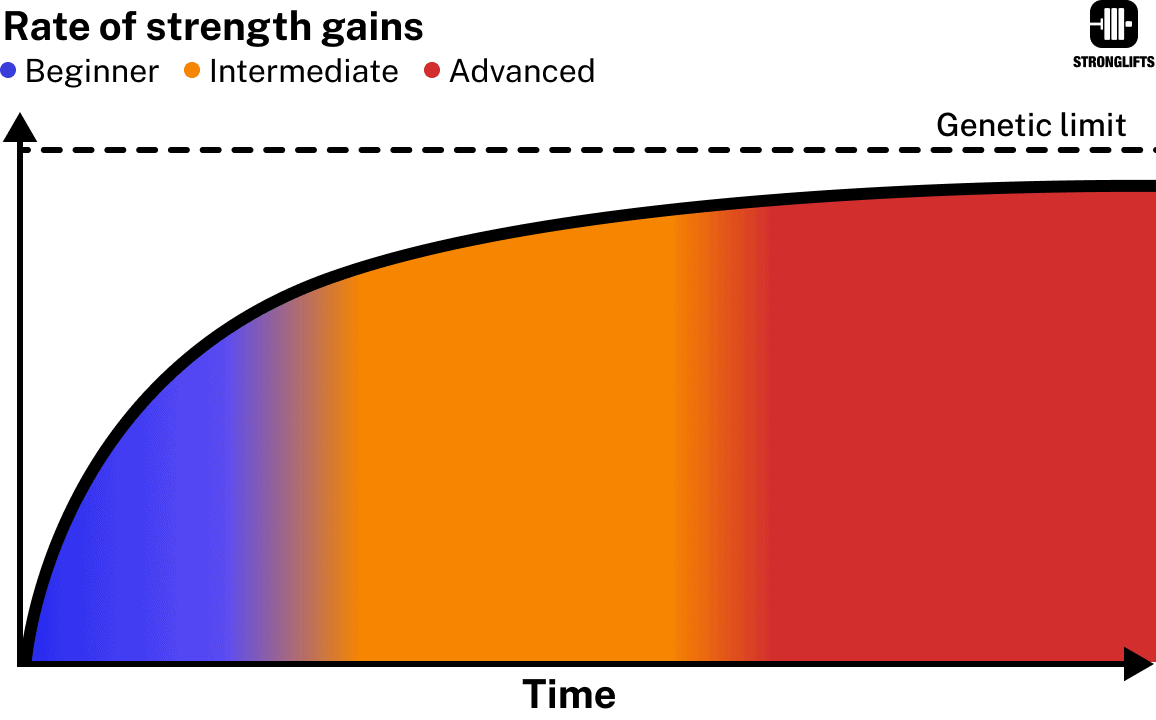
The stronger you become, the slower your progress becomes. Strength gains follow the law of diminishing returns (20, 21). The same rate of progress that quickly made you stronger initially becomes too much after a while. The time it takes for your body to get stronger starts exceeding the time between your workouts. Once your body doesn’t get stronger in time for the added weight on the bar, you start struggling to complete 5×5 straight sets.
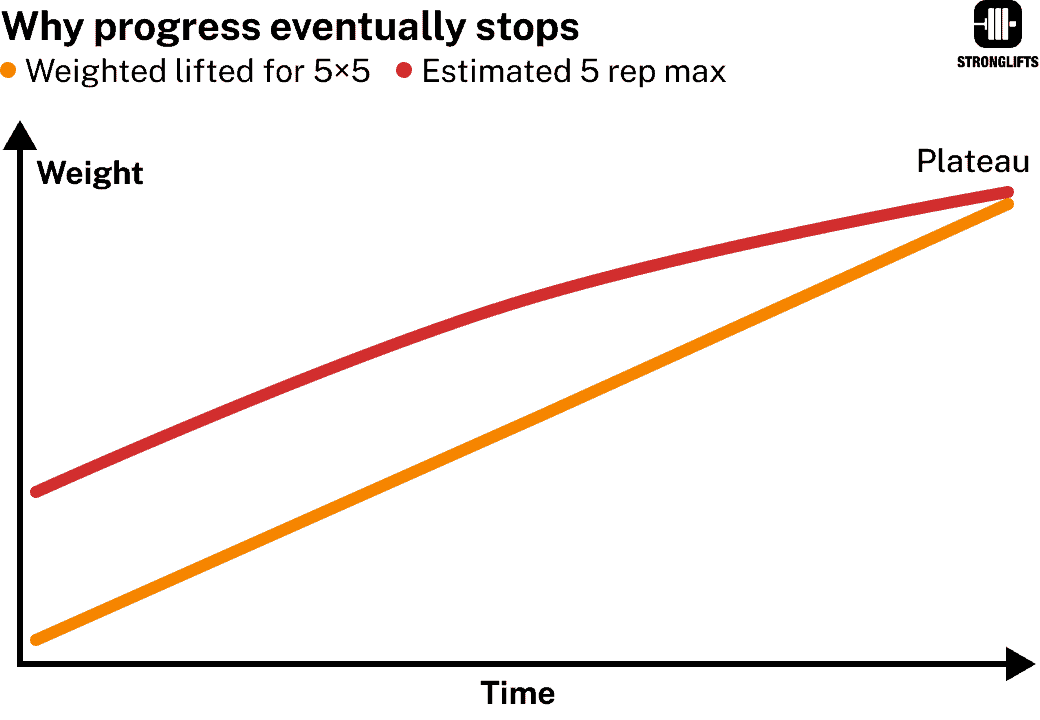
The same 5×5 workout that used to be easy to complete now requires more effort. Your strength is not increasing fast enough to stay ahead of your rate of progress. The result is that you’re now lifting weights closer to your max. The average RPE of your 5×5 straight sets has increased dramatically.
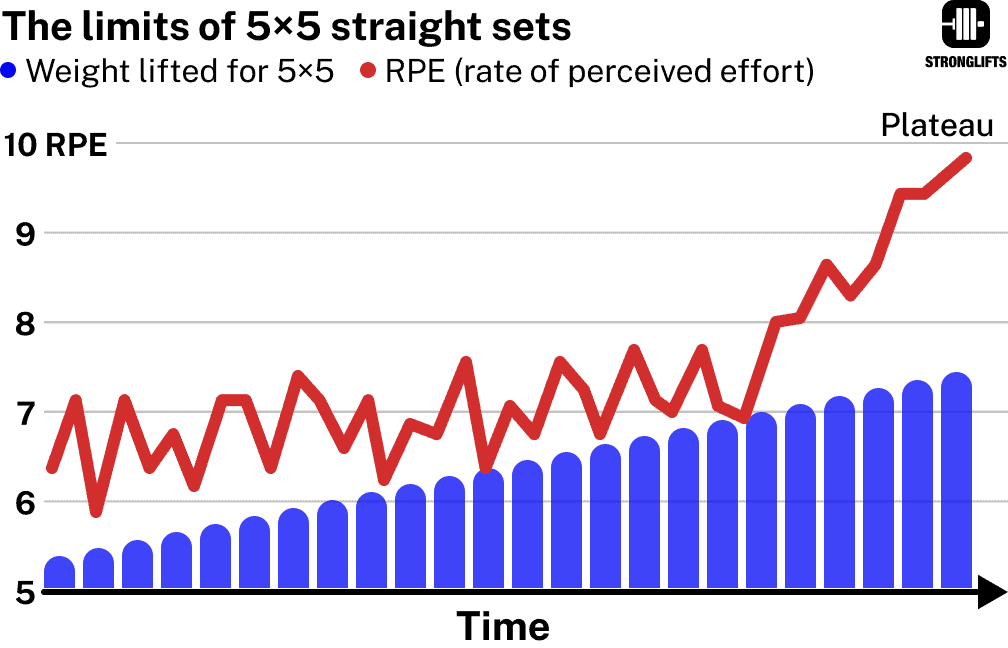
In the beginning, your average 5×5 RPE was 6-7. You could complete sets with short rest times without much effort. Yet you made progress because the effort-to-benefit is low for new, returning and weaker lifters (13).
Now your average 5×5 RPE is 8 or even 9. You need longer rest periods to complete your sets. You feel more tired after each workout. Your body doesn’t feel ready to add more weight on the bar.
| 5×5 straight sets | Start | Middle | End |
|---|---|---|---|
| Set 1 | 5x@5 | 5x@6.5 | 5x@8.5 |
| Set 2 | 5x@5.5 | 5x@7 | 5x@9 |
| Set 3 | 5x@6 | 5x@7.5 | 5x@9.5 |
| Set 4 | 5x@6.5 | 5x@8 | 5x@10 |
| Set 5 | 5x@7 | 5x@8.5 | 4x@10 |
| Average RPE | 6 | 7.5 | 9.4 |
Every set you do creates fatigue (12). Your body gets tired from your previous sets. That fatigue makes the next set harder to perform. Once the weights become too heavy, you start failing reps on the last sets.
| 5×5 straight sets | Hard | Too hard |
|---|---|---|
| Set 1 | 5x@8 | 5x@9 |
| Set 2 | 5x@8.5 | 5x@9.5 |
| Set 3 | 5x@9 | 5x@10 |
| Set 4 | 5x@9.5 | 3x@10 |
| Set 5 | 5x@10 | 2x@10 |
| Average RPE | 9 | 9.7 |
You can’t add weight next workout because you failed to complete 5×5. This can be frustrating because you were able to lift the weight for two or three sets of five. You just can’t do it for the full five sets.
The problem with longer rest periods
One simple and intuitive solution to force more progress out of Stronglifts 5×5 is to take longer rest periods between the 5×5 straight sets.
A study by Hernandez et al had 15 men Bench Press four sets with 85% of their max – about 92kg or 202lb (22). They were told to do as many reps as possible (AMRAP). One group rested 2min between sets. Another 5min. The last one 8min. Here’s how many reps each group completed…
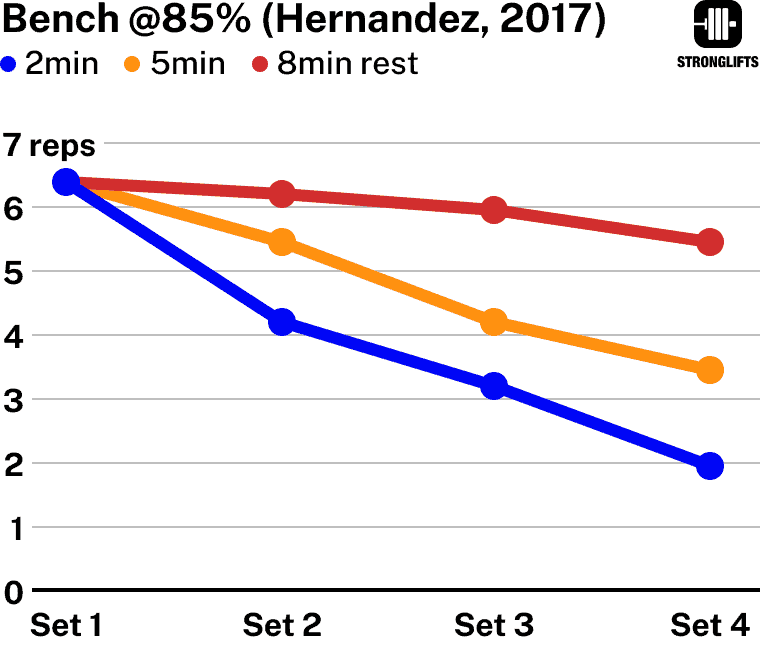
Longer rest times resulted in more reps done per set. Everyone who has been lifting for a while knows that. The group that rested 8min between sets Bench Pressed 52% more reps. Their total workout volume was higher.
| Hernandez, 2017 | 2min rest | 5min rest | 8min rest |
|---|---|---|---|
| Set 1 | 6.4 | 6.4 | 6.4 |
| Set 2 | 4.2 | 5.4 | 6.1 |
| Set 3 | 3.2 | 4.1 | 5.9 |
| Set 4 | 1.9 | 3.4 | 5.4 |
| Total reps | 15.7 | 19.3 | 23.9 |
| Total volume (kg) | 1448 | 1793 | 2207 |
Your body uses ATP and PCr for energy when you lift weights. Those energy stores deplete with each set. Longer rest periods give your body more time to recover these stores. Studies show that phosphocreatine (PCr) takes about 8min to fully recover after you do a set (23).
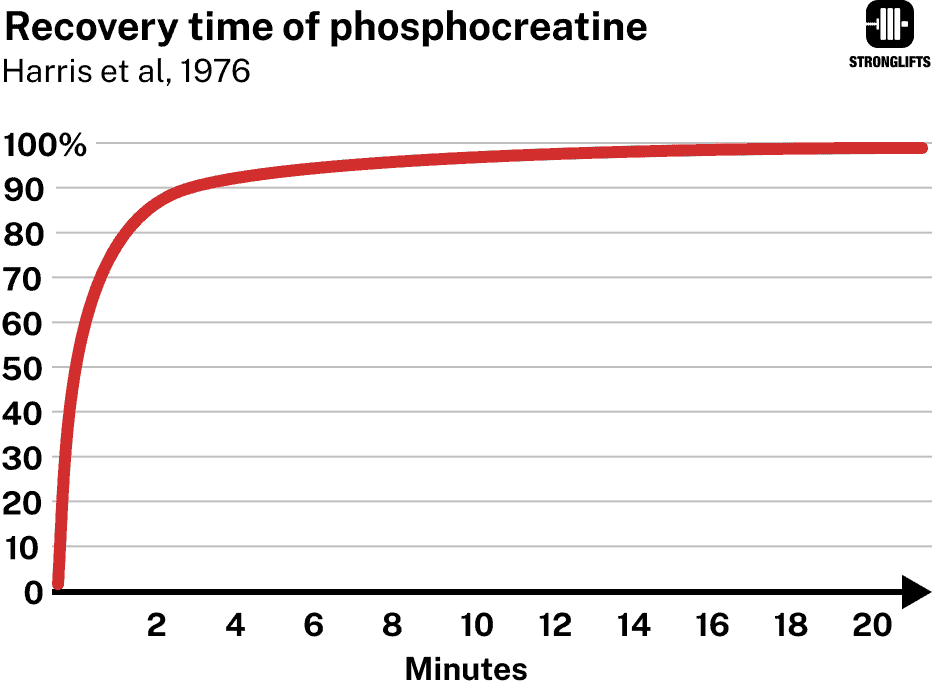
Your PCr energy stores are almost 10% more recovered after 8min than 2min rest. 10% may not seem much. But it explains why the group that rested 8min did 50% more reps than the group that rested 2min.
| Rest period | Recovery phosphocreatine (Harris, 1976) |
|---|---|
| 1min | 75% |
| 1min30 | 84% |
| 2min | 88% |
| 3min | 91% |
| 5min | 95% |
| 8min | 97% |
| 10min | 98% |
| 20min | 100% |
The problem is that longer rest periods make your workouts too long. In this study, the group that rested 2min between sets would have spent about 10min to Bench Press four sets. The group that rested 8min would have trained for more than three times longer to do the same workout.
| Hernandez, 2017 | 2min rest | 5min rest | 8min rest |
|---|---|---|---|
| Total sets | 4 | 4 | 4 |
| Time to execute set | 30sec | 30sec | 30sec |
| Rest between sets | 2min | 5min | 8min |
| Workout duration | 10min | 22min | 34min |
And that’s just for Bench. On Stronglifts 5×5 you also do Squats and Rows in workout A. Add your warmup. Add the time to set your equipment between lifts. If the only way to complete five reps is to rest +5min between every set, then you can easily spend more than two hours in the gym.
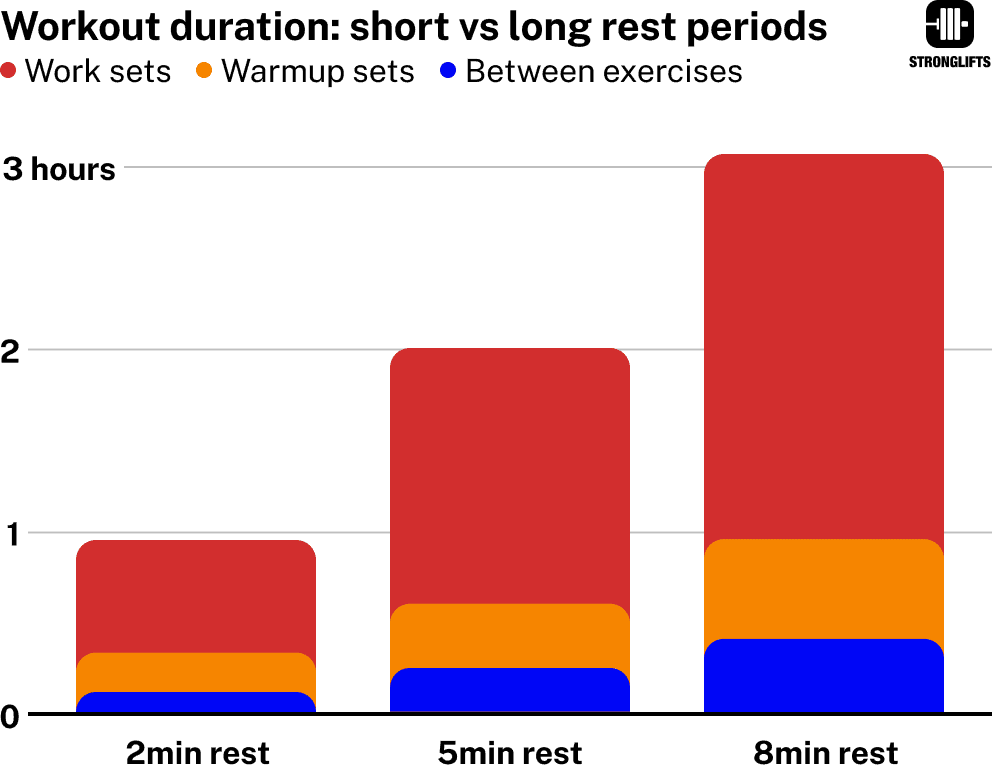
Two hour long workouts are too much for most people. They’re hard to fit into a busy schedule. It’s easy to lose focus when training that long. Your work capacity can also decrease from resting too long between sets.
There’s a better way: decrease the weight after your first set. You’ll be able to do five reps without long rest periods. They did this in a study by Ratamess et al (24). 8 men bench pressed 85% of their max for 5×5. Those are hard sets at RPE 10. They tested different rest intervals. If they couldn’t complete five reps, they lowered the weight by 5 to 15lb on the next set. Here’s how much weight they bench pressed for five sets of five…
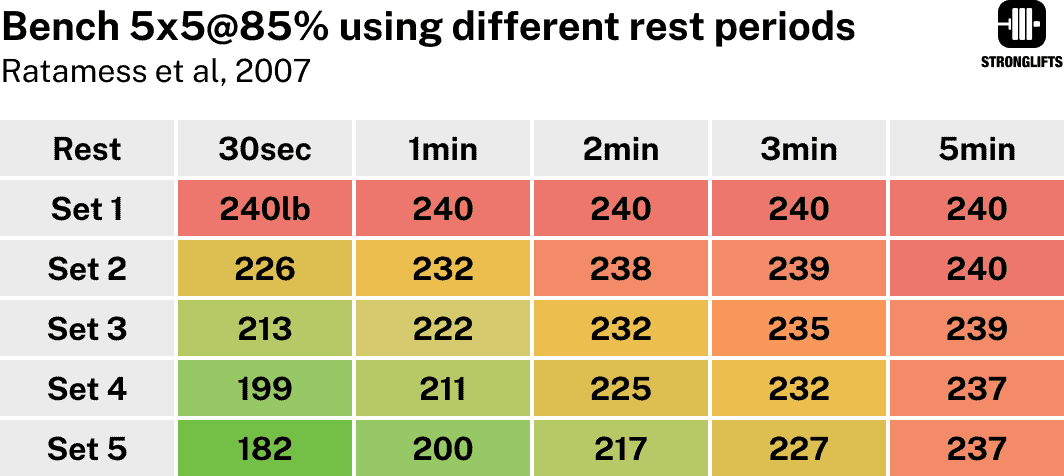
The 5min group barely needed to decrease the weight to keep completing five reps. That’s because they restored +20% more PCr between sets compared to the 30sec group. The researchers therefore recommended 3-5min rest for getting stronger on 5×5. But again, resting 5min between every set results in too long workouts. And so it’s unrealistic for most people.
That’s why we’re switching to top/back-off sets once 5×5 straight sets become too hard. And as it turns out, they’re just as effective for making gains.
Top/back-off sets explained
What are top/back-off sets
Top/back-off sets consist of one heavy set followed by several lighter sets. The heavy set is your top set. The lighter sets are your back-off sets. Between sets you take regular rest periods of two to three minutes.
Let’s say you Squat 5×5 240lb. If you switch to top/back-off sets, you start with one set of five reps with 240lb. After that decrease the weight by about 10% to 215lb. Now do four sets of five reps with that weight. Like this…
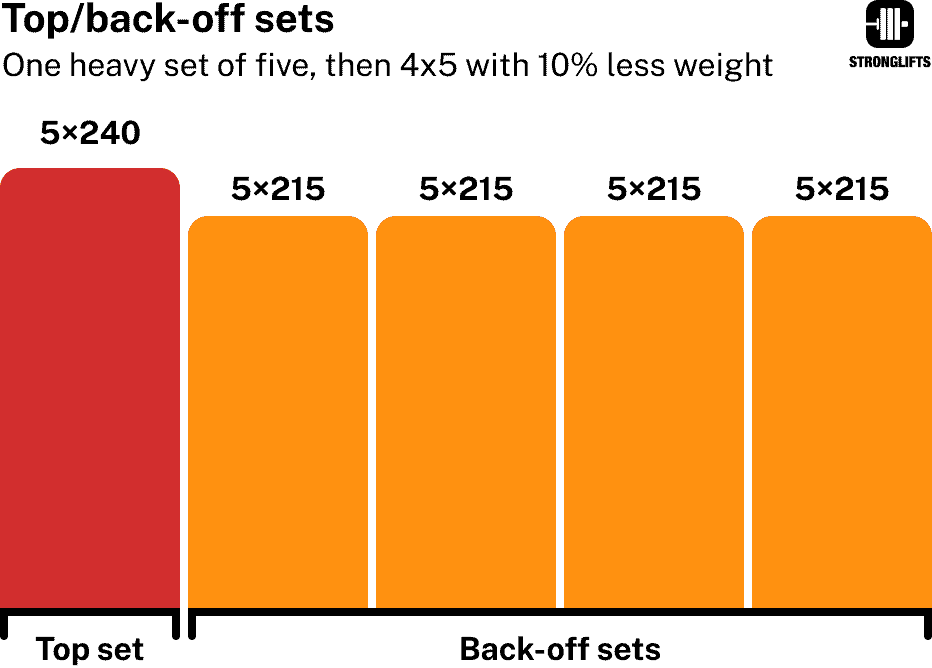
Table format:
| 5×5 top/back-off sets | Reps | Lb | Kg |
|---|---|---|---|
| Top set | 5 | 240 | 110 |
| Back-off set 1 | 5 | 215 | 100 |
| Back-off set 2 | 5 | 215 | 100 |
| Back-off set 3 | 5 | 215 | 100 |
| Back-off set 4 | 5 | 215 | 100 |
Top/back-off sets are not drop sets. You don’t do your top set of five, drop the weight, and then quickly do your back-off set without resting. You take regular rest periods between every set like when you do 5×5 straight sets.

The Stronglifts app supports top/back-off sets. Simply go to program – sets/reps – tap an exercise – then choose top/back-off sets. You’ll see the default 10% weight drop for the back-off sets. We’ll automatically do these calculations for you so you can focus on lifting.
Top/back-off sets: origins
I don’t know who invented the concept of doing top/back-off sets. But like many lifting principles it probably went like this…
A long time ago in a gym far, far away, one lifter did a really hard first set. They were so tired after that, that they decided to lower the weight for the next sets. They liked it, started doing top/back-off sets more, and realized that it worked well for building strength and muscle. And so they told all their gym friends. Over time the knowledge passed on to other lifters until it eventually became a popular sets & reps protocol – top/back-off sets.
Madcow 5×5 uses top/back-off sets in combination with ramp sets. You do four progressively heavier sets of five reps. You then do one heavy top set of three reps. After that you finish with one lighter back-off set of 8 reps. Madcow 5×5 was based on a program created by Bill Starr. I don’t remember when I started using top/back-off sets for the first time in my own training. It might have been with Madcow 5×5 about 20 years ago.
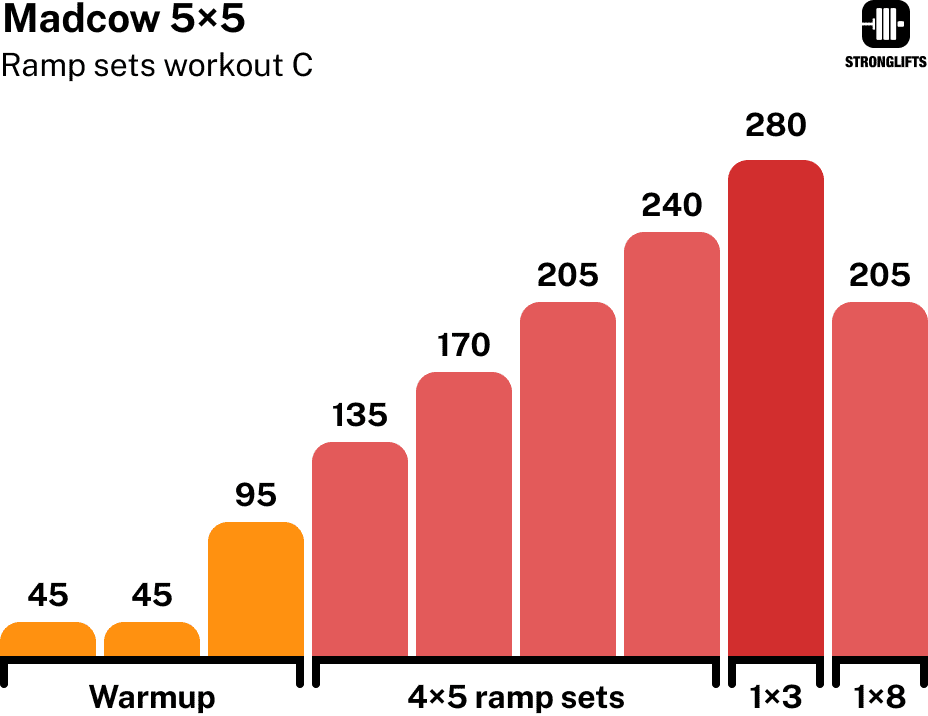
I definitely remember doing top/back-off sets a lot when Mike Tuchscherer started coaching me in 2011. My training logs go back to 2007 (I unfortunately didn’t keep a log during the first eight years of my lifting career). I checked the logs while writing this. The first year Mike coached me, not a week went by where we didn’t do a heavy top set followed by several back-off sets with about 10% less weight. I got a lot stronger with that.
Mike explained top/back-off sets in his book “The RTS Manual” (8). You would do one heavy set of say 5 reps at RPE9. After that you would lower the weight and keep doing sets of five. If you went over the goal RPE, you would stop. It was a way to autoregulate the volume. Year later exercise studies validated this training strategy (25). Mike’s ideas were quite ahead of their time.
How top/back-off sets stop failure
Top/back-off sets make it almost impossible to fail reps.
Fatigue builds up when you do 5×5 straight sets (12). Your body gets tired from your previous sets. This makes the next set harder to perform. The RPE goes up with each set. That’s why you typically fail on the last one or two sets once you’re past the easy beginner gains. Those are the sets with the most fatigue. You rarely fail on the first two sets because fatigue hasn’t accumulated yet. You’re still fresh from just starting the exercise.
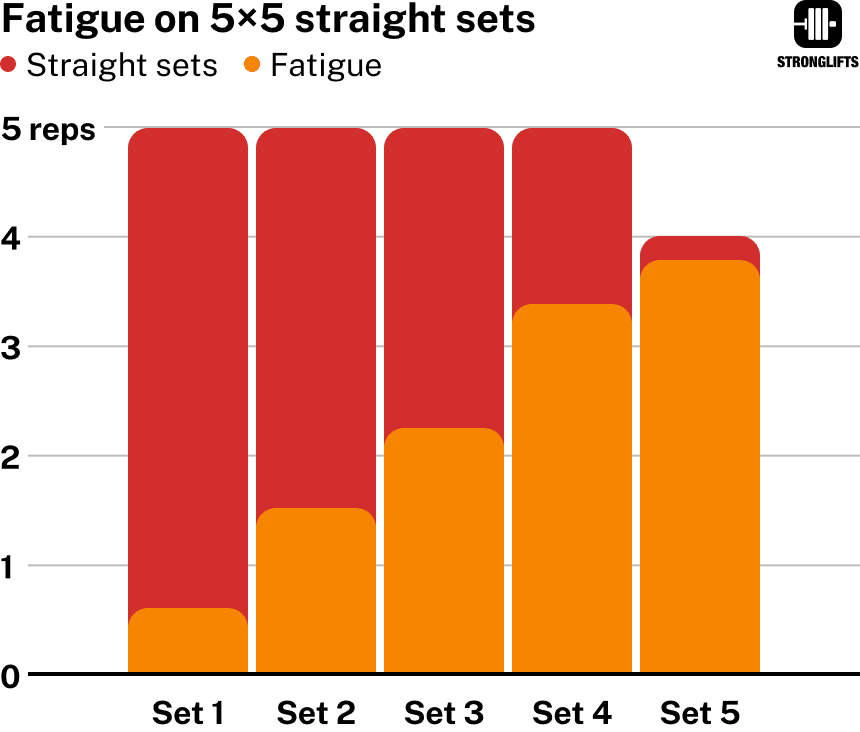
Top/back-off sets account for the fatigue five sets create. The four back-off sets are lighter than the top set. This makes the back-off sets less tiring. You still accumulate fatigue with each set but less than with straight sets. Instead of failing on the last sets, you keep completing five reps.
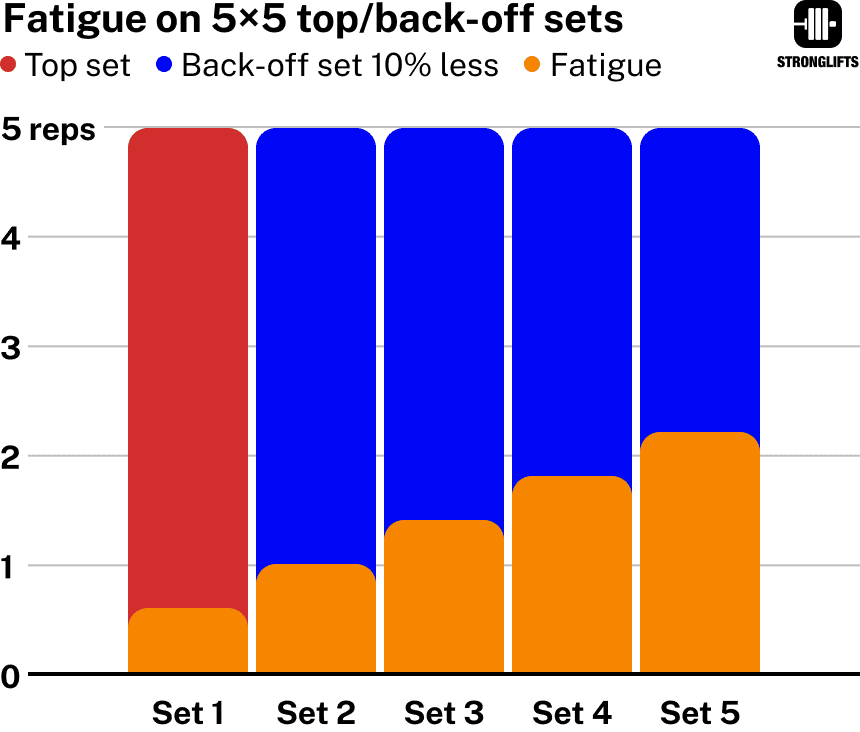
A study by Willardson et al tested top/back-off sets on 32 female lifters (26). They did 3×10 bench press with one minute rest. One group did straight sets. One reduced the weight by 5% per set. Another reduced it by 10% per set. Here’s how many reps they completed per set…
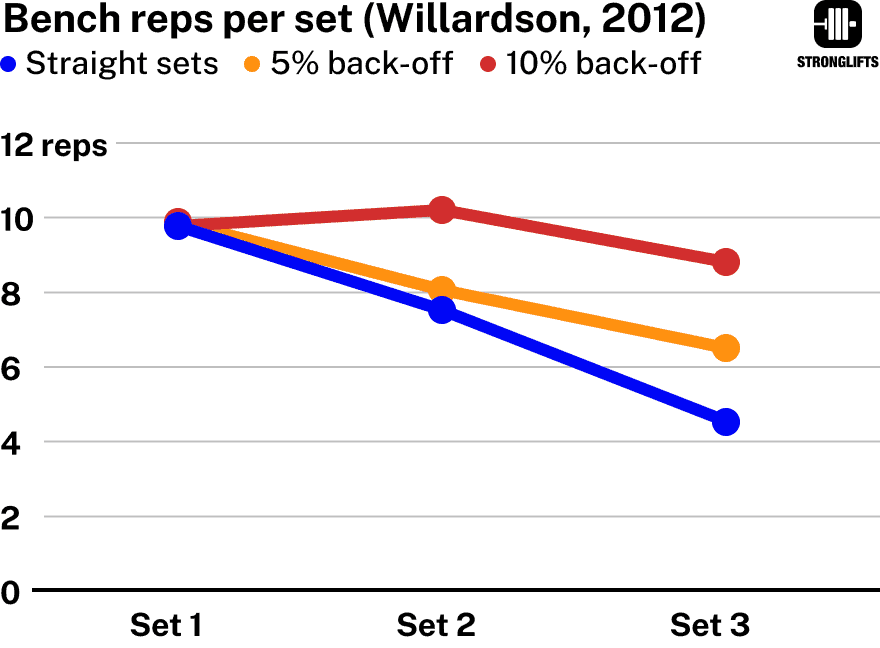
The group that did 3×10 straight sets couldn’t do 10 reps per set. But the group that used 10% back-off sets almost did. They only missed one rep. They did 32% more reps than the group doing 3×10 straight sets.
| Willardson, 2012 | Straight sets | 5% back-off sets | 10% back-off sets |
|---|---|---|---|
| Set 1 | 9.8 | 10 | 10 |
| Set 2 | 7.8 | 8.2 | 10.3 |
| Set 3 | 4.5 | 6.5 | 9 |
| Total reps | 22.2 | 24.7 | 29.2 |
A study by Medeiros et al found similar results (27). 24 men did four sets of leg press with their 10 rep max. They only rested one minute between sets. One group did straight sets. One group lowered the weight by 5% per set. Another by 10% per set. Here’s how many reps each group did per set…
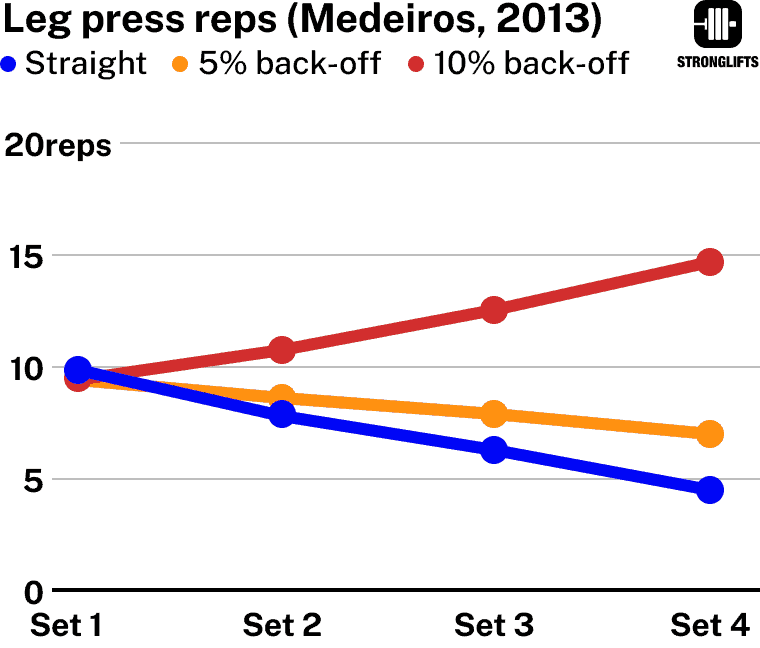
The 10% group did more reps. They actually increased the amount of reps they did as the sets went by. This is because your legs can handle fatigue better than your upper body (26). Leg exercises also use bigger and more muscles. This helps you do more reps than on bench or pullups (28).
The result is that the 10% group did more volume. This is important because doing more volume results in more muscle gains.
Here’s an example from Stronglifter Kevin, 62 years old. He switched from straight to top/back-off sets because he kept failing reps on the last three sets of the Bench Press. Quote…
This is working good so far – thanks so much! Really appreciate it and it mentally helps too – feels good to make progress again!
I could not get past 136 on my bench. My form was solid just could only get 3 reps on the last 3 sets on 5×5. Since changing over to top/back-off sets, the first set is hard but doable and I am adding 1/2 pound every other workout and have moved past 138 now – with drop down to 127. I am sure there is a mental thing here – getting discouraged not progressing. Now I know it’s one hard set and done – kind of like on the deadlift. You know it’s over after one – then the sets are easier.
I think too at 62 yrs old there is more of a fatigue factor – especially following a hard squat workout. So just having one hard set and backing off really helps with that. So maybe this works better for older guys??? I know I will do this on squats when I get stuck there.
That’s my thoughts – I definitely like it and so glad you suggested it. It will be interesting to see where I am at with it in a couple months.
Appreciate this program so much and the App is amazing! I share it with everyone who will listen. I am 10 months into this now and if I hit my goals I will be stronger at 62 than I was at 29 when I was lifting regularly. ( except for bench – but I will be close). Man I wish I had heard about this back then! Thanks again for all you do!
Kevin, 62y, USA
You can switch to top/back-off sets in the Stronglifts app by going to program – sets/reps – tap an exercise – then choose top/back-off sets. By default we’ll automatically lower the weight for you by 10% on your back-off sets.
How top/back-off sets increase volume
Volume is set × rep × weight. Top/back-off sets help you complete more reps. This increases your volume. Volume is important for building strength and muscle (29, 30). You need to add weight over time (3, 4). But you also need to do enough work. Just one heavy rep isn’t enough to progress.
The study by Medeiros et al found that the group that decreased the weight by 10% per set did more volume than the group that did straight sets (27).
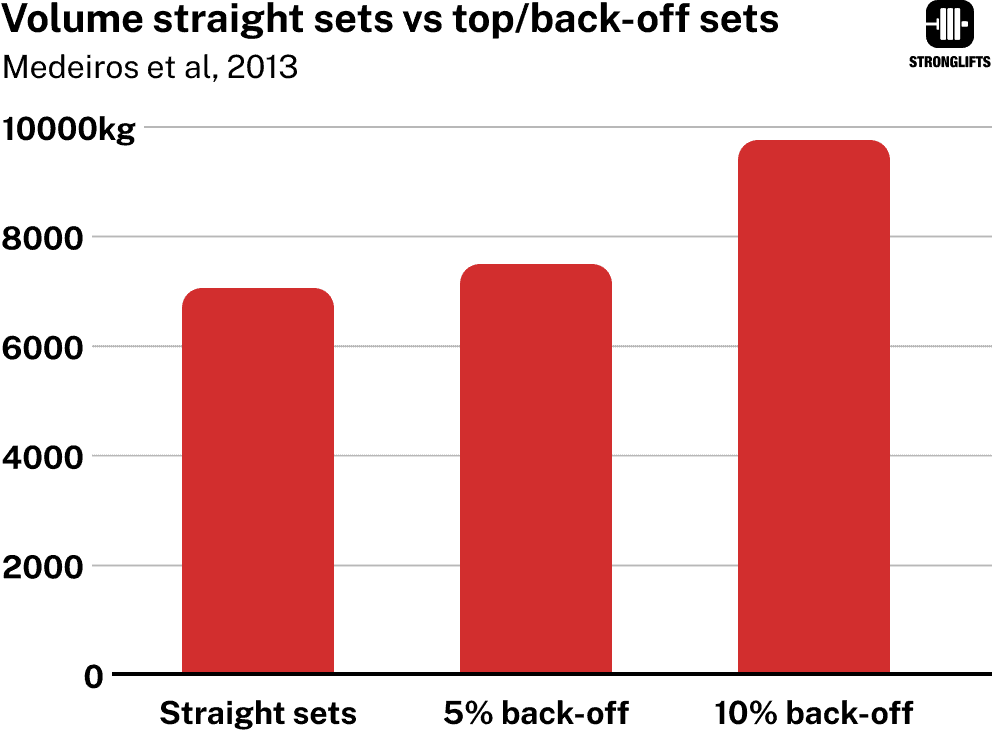
When you switch from 5×5 straight sets to 5×5 top/back-off sets on Stronglifts 5×5, you increase volume in two ways:
- You’re lifting a heavier weight on the top set
- You’re doing more total reps than with straight sets
Say you’ve reached 300lb for 5×5 on the Squat. But the weight has become too heavy. The RPE is too high and you’re missing reps. Those missed reps decrease your volume. Instead of doing 25 reps with 300lb you only get 22. Your volume is 6600lb instead of 7500lb. Compare the difference in volume when you use top/back-off sets…
| Protocol | Straight sets | Top/back-off sets |
|---|---|---|
| Set 1 | 5x300lb@8 | 5x315lb@9 |
| Set 2 | 5x300lb@8.5 | 5x285lb@7 |
| Set 3 | 5x300lb@9 | 5x285lb@7.5 |
| Set 4 | 4x300lb@10 | 5x285lb@8 |
| Set 5 | 3x300lb@10 | 5x285lb@8.5 |
| Average weight | 300lb | 291lb |
| Average RPE | 9.1 | 8 |
| Total volume | 6600lb | 7275lb |
Lowering the weight 10% on the back-off sets makes them easier to lift. You don’t fail reps which increases volume. You get another boost in volume from the top set which can be almost 5% heavier than with 5×5 straight sets.
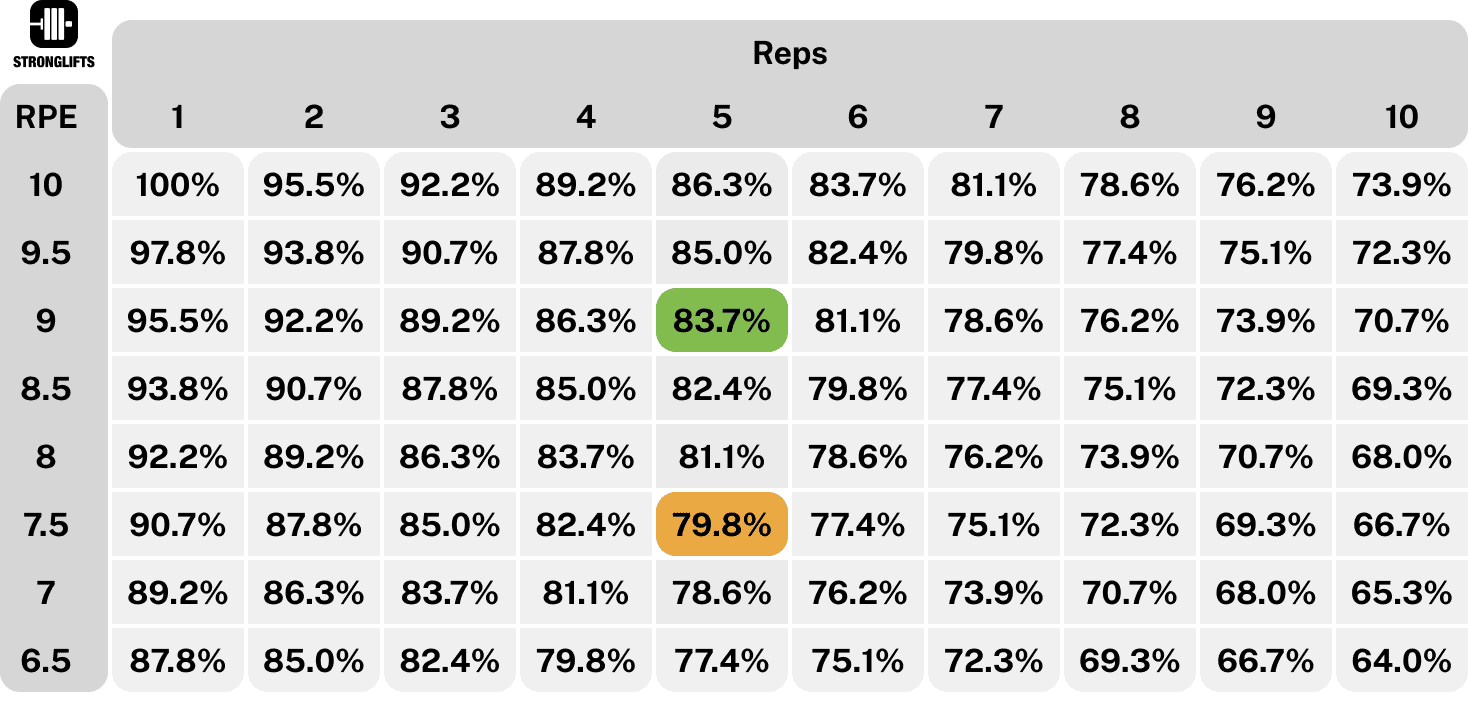
With 5×5 straight sets you need to stay at RPE 7-8 to lift the same weight for five sets. With top/back-off sets you can take set one to RPE 9 because the next sets will be lighter. That’s a 15lb difference on a 300lb Squat.
Why top/back-off sets are less tiring
Your average workout RPE plummets when you switch from 5×5 straight sets to top/back-off sets. Each workout causes less fatigue.
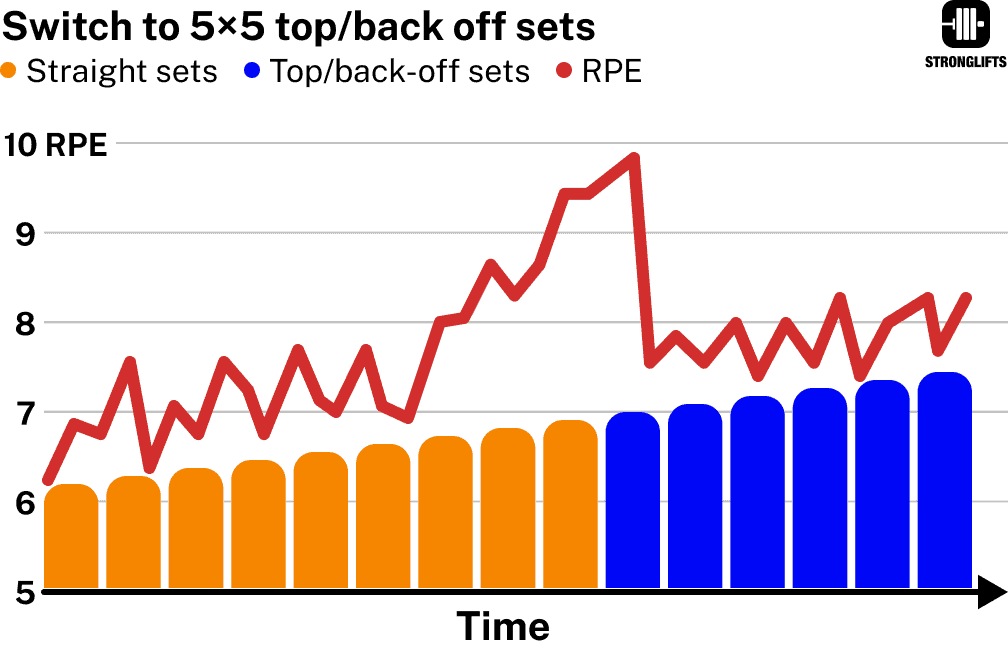
A study by Lima et al made 21 men do biceps curls 3x/week for 16 weeks (12). They did 3×10 with one minute rest. One group did straight sets. One decreased the weight by 5% per set. Another by 10%.
The RPE was lower for the 10% group. Compare…
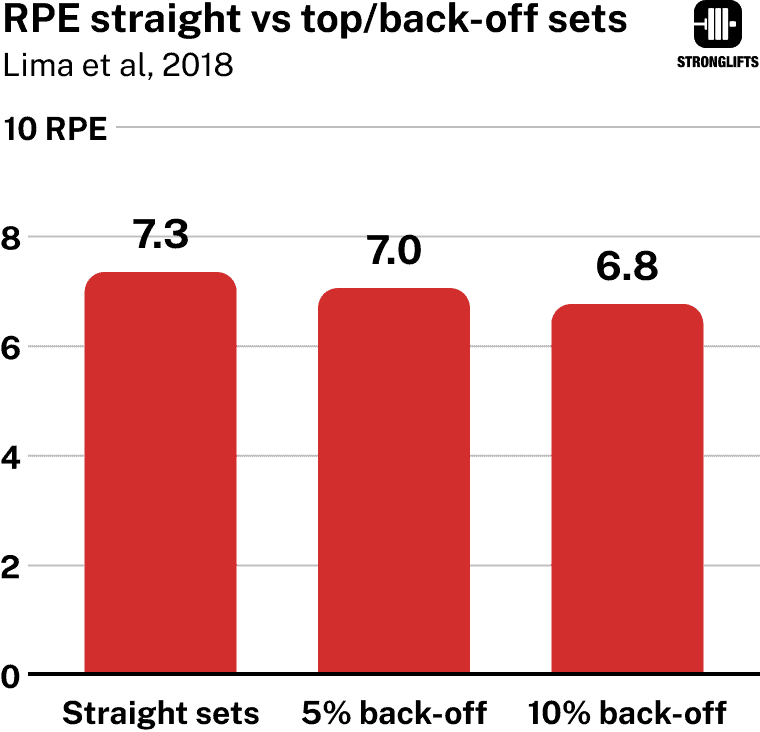
The workouts of the 10% group were easier. Yet they built the same amount of strength and muscle. They made the exact same gains but without pushing themselves to the absolute limit. How does that sound to you?
To understand how this is possible, let’s look back at the table comparing hard 5×5 straight sets where you fail reps with 5×5 top/back-off sets.
| Protocol | Straight sets | Top/back-off sets |
|---|---|---|
| Set 1 | 5x300lb@8 | 5x315lb@9 |
| Set 2 | 5x300lb@8.5 | 5x285lb@7 |
| Set 3 | 5x300lb@9 | 5x285lb@7.5 |
| Set 4 | 4x300lb@10 | 5x285lb@8 |
| Set 5 | 3x300lb@10 | 5x285lb@8.5 |
| Average weight | 300lb | 291lb |
| Average RPE | 9.1 | 8 |
| Total volume | 6600lb | 7275lb |
The average weight and RPE are lower because the back-off sets are 10% lighter. You don’t fail reps which increases your volume. The one heavy top set seems to be enough to drive strength progress.
Why top/back-off sets are easier
Top sets make back-off sets easier to lift.
If you Squat 5x315lbs first, then Squatting 4×5 285lb next is easier. You just lifted 30lb more. The back-off sets are like your warmups. The top set makes your muscles “wake up”. It gives you a boost that helps you lift weight more easily after that. This is called postactivation potentiation or PAP.
A study by De Freitas et al tested the impact of PAP on men Squatting about 104.6kg or 235lb (31). They did four sets AMRAP – as many reps as possible with 70% of their max. They took 2min rest between sets.
- The PAP group did one heavy set of two reps with 90% of their max or about 210lb. Then they did four AMRAP sets with 165lb.
- The no-PAP group jumped straight into four AMRAP sets with 165lb without doing the heavy set of two reps first.
Here’s how many reps both groups completed on the AMRAP sets…
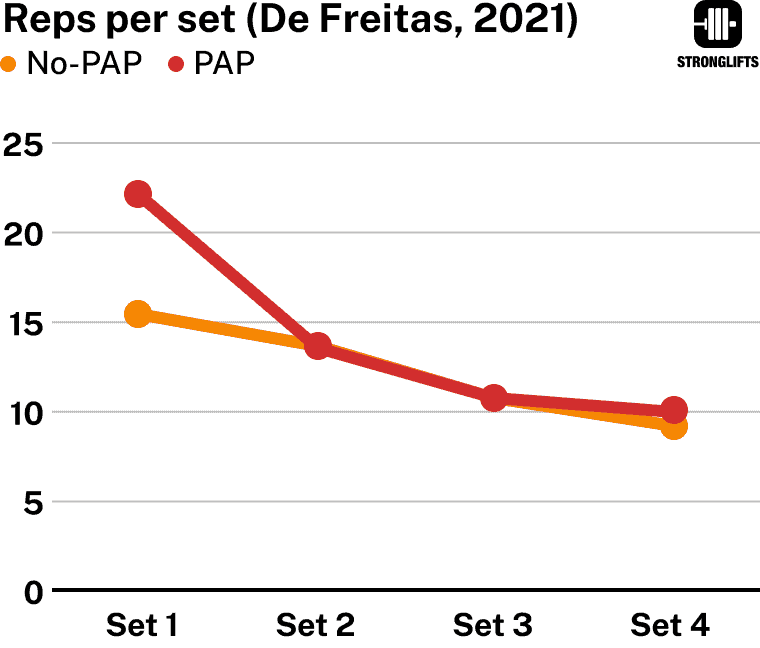
The PAP group did 22 reps on the first set vs only 15 for the no-PAP group. There wasn’t any difference between sets two to four because the PAP group went so hard on that first set. Those +20 reps Squats probably exhausted them for the next three sets. It didn’t help that they only rested two minutes and took every set to failure by doing AMRAPs.
But the point is that the heavier PAP set made the lighter back-off set easier. They did more reps on the next set. This resulted in more volume for the PAP group – they did 56 reps in total vs only 48 for the no-PAP group.
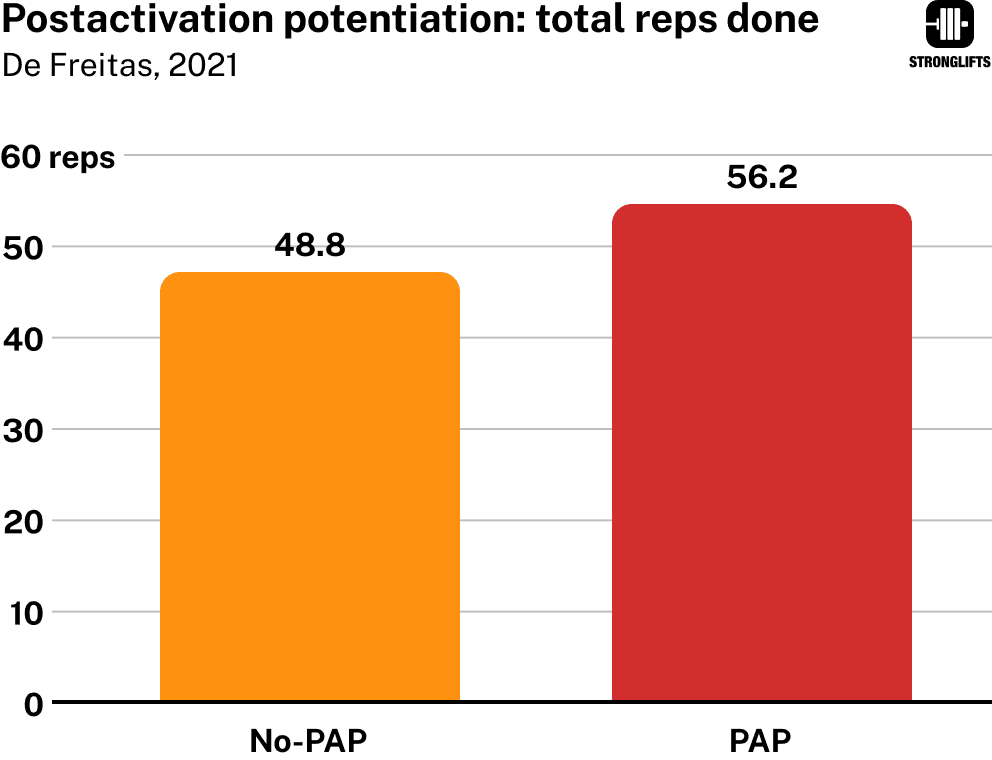
5×5 top/back-off sets give you similar benefits. The heavier top set is a form of PAP. It makes the four lighter back-off sets easier. It’s also easier to motivate yourself to do just one really hard set. You can give it your all since the next four sets will be lighter and easier. If you’re not happy with your form, you can improve it on the lighter back-off sets by focusing on quality reps.
Why top/back-off sets take less time
You don’t need 5 min rest for your back-off sets. They’re lighter and easier and so 2-3 min rest is enough. This keeps your workouts short.
Let’s look at the 5×5 Bench Press study from Ratamess et al again (24). They decreased the weight on each set so they could keep completing five reps per set. Compare the back-off percentage at different rest intervals…
| Rest | 30sec | 1min | 2min | 3min | 5min |
|---|---|---|---|---|---|
| Set 1 | 240lb | 240lb | 240lb | 240lb | 240lb |
| Set 2 | 226lb | 232lb | 238lb | 239lb | 240lb |
| Set 3 | 213lb | 222lb | 232lb | 235lb | 239lb |
| Set 4 | 199lb | 211lb | 225lb | 232lb | 237lb |
| Set 5 | 182b | 200lb | 217lb | 227lb | 237lb |
| Back-off % | 24% | 17% | 10% | 6% | 1% |
If you don’t lower the weight of your back-off sets, you’ll need 5 minutes rest between back-off sets to complete five reps per set. If you rest less than a minute, then you’ll need to decrease the weight by about 20%. But if you rest 2-3 min, then lowering the weight by about 10% is enough.
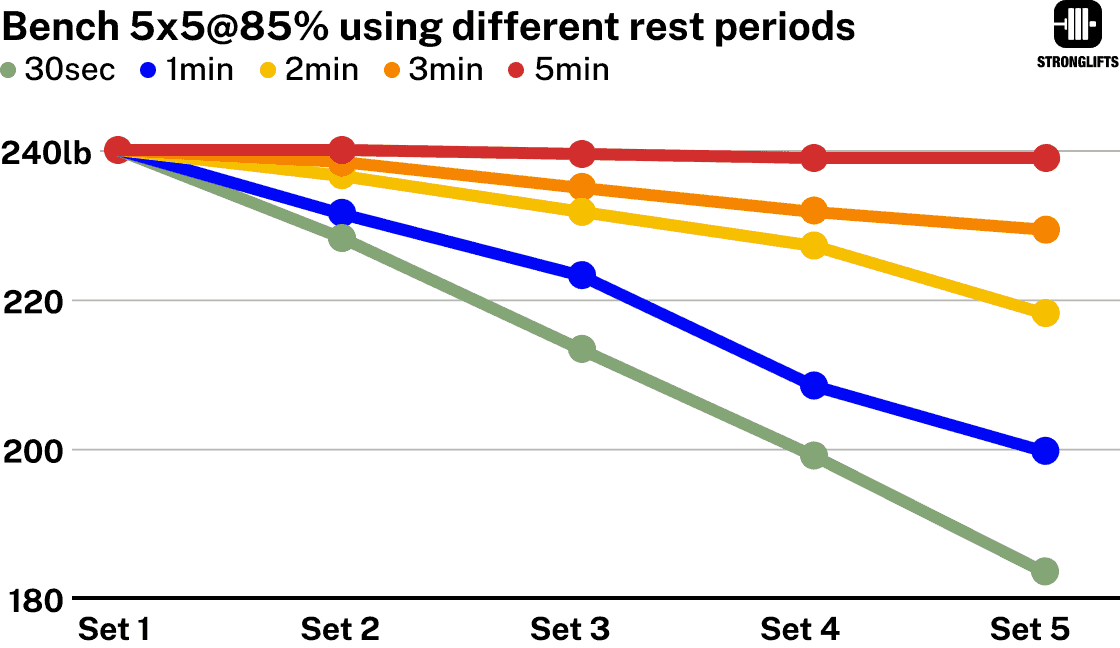
Resting 2-3 min between sets halves your workout time compared to resting 5 min. You’re out of the gym faster while getting similar gains.
Here’s an example from Stronglifter Ryan, 41 years old. He switched from straight to top/back-off sets because he was failing reps on the Overhead Press. This change reduced his rest periods. His last workout only took 42min, including his warmup sets and Chinups as assistance work.
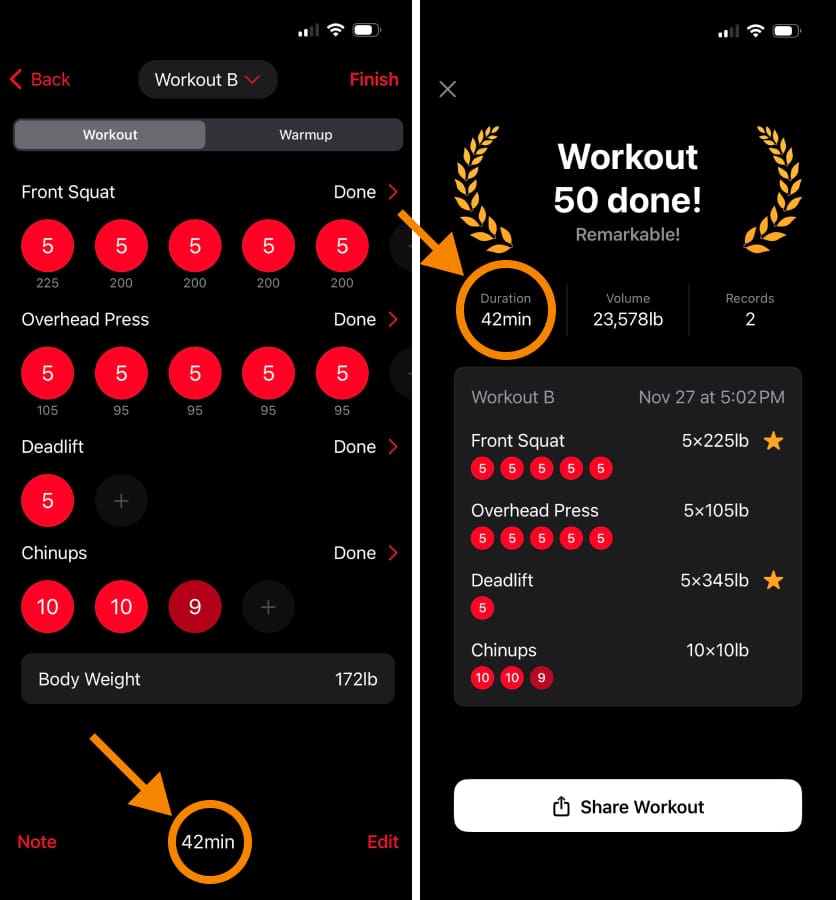
Quote from Ryan…
I took your advice from a previous email about reaching failure on a lot of my upper body sets (I have two metal plates in my clavicle and it has always made OHP and BP very challenging).
So I am now doing top/back-off sets on everything, and this was helpful because I also was looking for a slight time-saver as my sessions were getting a bit too long to feasibly fit in my schedule.
I was in and out with full Warm-up sets in 42 minutes. I even got in my 3×10 of chin ups. More so, I was able to bring my rest between sets down to two minutes. And it also felt great to really focus on perfect form during those back off sets. It made it so much easier after doing one set heavier.
Stronglifter Ryan, 41.
The screenshot above is taken from the Stronglifts app. You can switch to top/back-off sets in the app by going to program – sets/reps – tap an exercise – then choose top/back-off sets. By default we’ll automatically lower the weight for you by 10% on your back-off sets.
Getting started with top/back-off sets
When to switch to 5×5 top/back-off sets
You should switch from 5×5 straight sets to top/back-off sets in any of the following situations:
- You’re struggling to complete five reps on all five sets. You can do the first 2-3 sets for five reps. But you always fail reps in the last two sets. Switch to top/back-off sets and you’ll stop failing.
- Your Squat has increased a lot. You feel more tired after each workout. You’re not recovering as fast as you did before. Switch to top/back-off sets and the workouts will be easier.
- Your workouts are taking too long. You can’t complete 5×5 without resting five minutes between every set. Switch to top/back-off sets and you’ll be able to progress with shorter rest periods of 2-3 minutes.
Different exercises progress at different rates. You’ll usually need to switch on the Overhead Press and Bench Press before Squats. You can switch all three exercises and Barbell Rows at once if you want.
The Stronglifts app supports top/back-off sets. Simply go to program – sets/reps – tap an exercise – then choose top/back-off sets. You’ll see the default 10% weight drop for the back-off sets. We’ll automatically do these calculations for you so you can focus on lifting.
How to progress and add weight
Progress by adding weight on the top set.
Your back-off sets should be about 10% lighter than your top set. And so your back-off sets will progress with your top set. Like this…
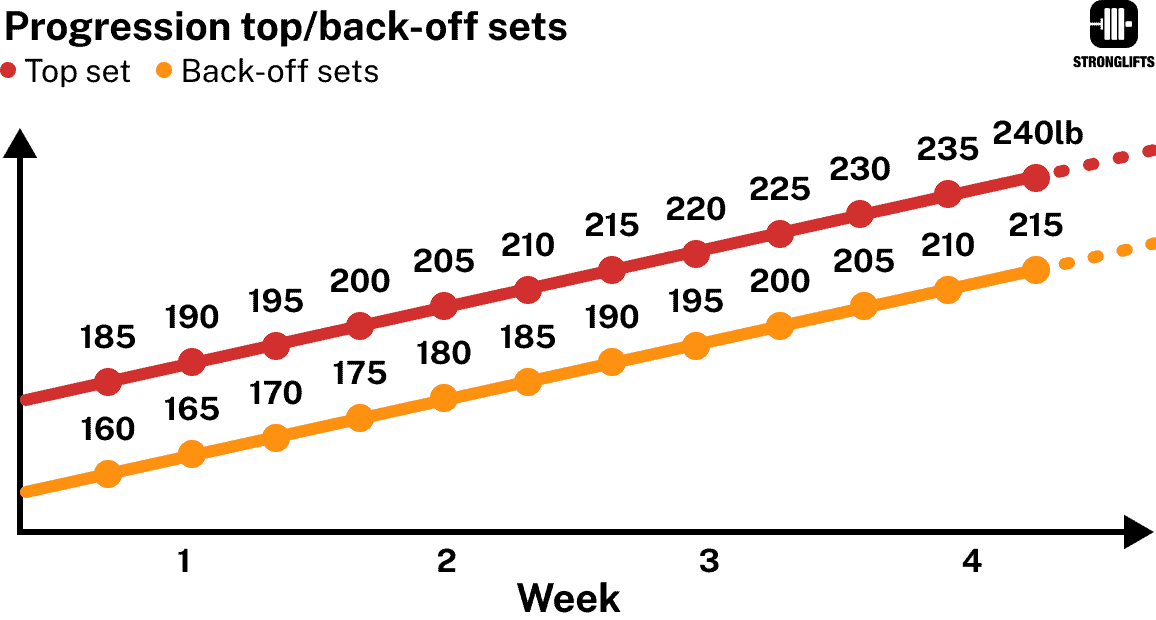
Table format…
| Workout | Top set | Back-off sets |
|---|---|---|
| 1 | 5×240 | 4×5 215 |
| 2 | 5×245 | 4×5 220 |
| 3 | 5×250 | 4×5 225 |
| 4 | 5×255 | 4×5 230 |
The Stronglifts app automatically increases the weight on the top set for you. It then calculates your back-off sets by taking 10% off the top set (or 5-20% if you prefer). Just let it do all the thinking so you can focus on lifting.
Rest periods for top/back-off sets
Rest 3-5 min before doing your heavy top set, after your last warmup set. Rest about 2-3 min between your lighter and easier back-off sets.
| Sets | Rest period |
|---|---|
| Top set | 3-5 min |
| Back-off sets | 2-3 min |
Your top set is heavier. Resting longer before doing this harder set gives your PCr stores more time to recover (23). This helps you complete five reps more easily (24). It makes you less likely to fail reps on your top set.
| Rest period | Recovery phosphocreatine (Harris, 1976) |
|---|---|
| 1min | 75% |
| 1min30 | 84% |
| 2min | 88% |
| 3min | 91% |
| 5min | 95% |
Your back-off sets are lighter and easier. And so you don’t need 5min rest for these sets. 2-3min is usually enough to complete five reps without failing. Limiting your rest periods on your back-off sets saves gym time.
Only rest 5min before your top set if you don’t think you can get five reps otherwise. Refer to your last workout for this. If you rested 2min last time, and you struggled to complete five reps, then try resting 3-4min this time. You’re not “cheating” by doing this. You’re simply taking advantage of fuller PCr energy stores which help you complete more reps (23, 24).
Resting 5min on your top sets won’t affect your gym time much. You don’t do more than three per workout. And you don’t need 5min rest on the top set of every exercise. But you do up to 12 back-off sets. These are the sets where you can save the most amount of time. Be strict with your rest periods. The back-off sets are lighter and easier. You can rest less without issues.
| Rest period | Shorter rest | Longer rest |
|---|---|---|
| Top set | 3min | 5min |
| Back-off set 1 | 2min | 3min |
| Back-off set 2 | 2min | 3min |
| Back-off set 3 | 2min | 3min |
| Back-off set 4 | 2min | 3min |
| Set duration | 20sec | 20sec |
| Exercise duration | 13min | 19min |
| Workout duration | 38min | 56min |
The above workout duration doesn’t include your warmup sets. But they’re even lighter and easier than your back-off sets. So they definitely don’t need 2-3min rest. You can simply add weight on the bar and do your next warmup set. Rest 2-3 min before doing your last warmup set only. Rest a bit longer for your top set. Then take shorter rest periods for your back-off sets.
If you’re strict with your rest periods you can finish your workout in an hour.
Frequently asked questions
Are top/back-off sets the same as drop sets?
No. Back-off sets are different from drop sets (32).
- With drop sets you Bench a set, rack the bar, drop the weight and quickly do another set. You may only rest 30sec before doing the drop set. And so you’re more likely to reach failure on the drop set.
- With top/back-off sets you Bench a heavy set, rack the bar, and also decrease the weight. But you rest 2-3min before doing the back-off set. You don’t rush. And so you’re not hitting failure on the back-off set.
Here’s how 5×5 top/back-off set looks like. Notice how you always rest before doing the next set.

The rest periods of 2-3min help you complete more reps and/or lift a heavier weight on your back-off sets than if you did a drop set with only 30 seconds rest or less. This was shown in the study by Ratamess (24). The groups that rested longer between sets were able to lift heavier weights.

Resting after your top set and between back-off sets reduces fatigue. This helps you focus better and lift with better form. In fact, the rep quality on your back-off sets is usually higher than on your top set. You’re less tired because the weight is lighter and fatigue is lower.
With drops sets fatigue can’t dissipate. It accumulates. This isn’t an issue if you’re doing machine exercises that balance the weight for you. It’s also not an issue if you do isolation exercises that are less technical. But with free weight, compound lifts like the Squat and Deadlift your form will break down more. Most people don’t have the muscular endurance to keep proper form when doing set after set without resting. This is an easy way to get hurt.
Drop sets are fine for assistance work like curls. But there are no drop sets on the main, free weight, compound exercises of Stronglifts 5×5. We use straight sets or top/back-off sets for these lifts. We rest between sets.
How much weight should you use for the back-off sets?
A 10% weight reduction is enough if you rest 2-3min between sets. You’ll be able to get five reps on every back-off set without failing reps.
If you rest less than a minute, you’ll need to lower the weight by 17-24% to complete five reps per set (24). While this can save you time, it also reduces your training intensity. The weight you’ll lift may be too low. This can hurt your strength gains if you’re past the easy beginner gains. Remember more experienced lifters need to train heavier to increase strength (13).

Too short rest times can result in failed reps on the back-off sets. This would lower your training volume and thus result in less muscle gains. You’d have to do extra sets to get the same amount of volume. It’s more time-efficient to take proper rest between sets so you don’t have to do extra sets (33).
Best is to rest 2-3min between your back-off sets. You won’t need to decrease the weight by more than 10%. Say your top set is 300lb, and you rest 2-3min between sets, then 270lb for your back-off sets is fine. You should be able to do 2-3 more reps per set on every back-off set (RPE 7-8).
Should you decrease the weight on every set?
No. Do your top set, lower the weight by 10%, and then do your next four back-off sets with that weight. Like this:

Several of the studies I’ve referenced decreased the weight on every back-off set (12, 26, 27). They did something like this…
| Protocol | Set 1 | Set 2 | Set 3 |
|---|---|---|---|
| Straight set | 300lb | 300lb | 300lb |
| 5% back-off set | 300lb | 285lb | 271lb |
| 10% back-off set | 300lb | 270lb | 243lb |
They did this because they only took one minute rest between back-off sets (12, 26, 27). This gives your body no time to recover. Your PCr energy stores are only 75% recovered after one minute (23). If they didn’t lower the weight on every back-off set, they would be missing a lot of reps.
This was shown in the study by Ratamess et al (24). The group that rested only one minute between sets had to decrease the weight by 17% over the course of five sets vs only 6% for the group that rested 3min.
| Rest | 30sec | 1min | 2min | 3min | 5min |
|---|---|---|---|---|---|
| Set 1 | 240lb | 240lb | 240lb | 240lb | 240lb |
| Set 2 | 226lb | 232lb | 238lb | 239lb | 240lb |
| Set 3 | 213lb | 222lb | 232lb | 235lb | 239lb |
| Set 4 | 199lb | 211lb | 225lb | 232lb | 237lb |
| Set 5 | 182b | 200lb | 217lb | 227lb | 237lb |
| Back-off % | 24% | 17% | 10% | 6% | 1% |
You’ll be resting 2-3min between your back-off sets. And so a one-time 10% decrease in weight is enough to complete five reps on all sets.
Can you start Stronglifts 5×5 with top/back-off sets instead of straight sets?
You can start Stronglifts 5×5 with top/back-off sets if you’re an experienced lifter. This means…
- You were doing a different program until last week or so, and are now switching to Stronglifts 5×5.
- You’re not new to the Squat, Bench and Deadlift. You’ve already learned proper form on a previous program.
- You’ve already built a good base of strength and muscle mass from the previous program, and so you’re lifting heavier weights.
If you can lift heavier weights already, then 5×5 straight sets may be too hard for you. The Squats in particular can be quite a challenge. Your workouts will be easier if you start with top/back-off sets instead.
However, if you’re a new, returning or weak lifter, I recommend starting with 5×5 straight sets for reasons explained here.
What if you want to switch back to 5×5 straight sets?
You’ll have to decrease the weight. Take the weight that you lifted on your back-off sets, and use that as your weight for 5×5 straight sets. So if you were doing 5x300lb, 4×5 270lb then switch to 5×5 270lb.
Switching back to 5×5 straight sets makes sense if you quit lifting for several months, and are now returning to the gym. It also makes sense if something is hurting, and you prefer to remove the heavier top set for now.
Which is best? Straight or top/back-off sets?
There’s no best. Every set & rep protocol has its pros and cons. It depends on the context in which you’re going to use it. Example…
- Top/back-off sets allow you to go heavier. You can practice lifting a heavier weight for five reps on the top set. You can practice grinding. But the next four back-off sets are lighter, less fatiguing, and you don’t fail reps. This is better if you’re past the easy beginner gains.
- Straight sets prevent you from going too heavy. You’re forced to use a lighter weight because you have to repeat it for five sets. This is better if you’re a new lifter. But it’s also better if say your back hurts. You don’t want to grind a heavy top set in this situation.
There’s not one way to lift. There’s a wide range of tools that you can put in your training toolkit. When you started Stronglifts 5×5, you learned straight sets. Now you learn top/back-off sets. Later on Madcow 5×5 you’ll learn ramp sets. These three protocols all have their pros and cons. You learn these by using them. That then helps you use the right tool for the job as you get into different situations over your training career.
Say you think top/back-off sets are “best”. You only use this tool for the next six months. It’s probably no longer the “best” for you. Your body adapts to everything, remember? What’s “best” now may be to do something else. Do straight sets for a while to get a change. Many lifters get stuck in a rut by repeating the same workouts for years and then wonder why they can’t progress. It’s because your body adapts to your workouts.
Why doesn’t the Stronglifts app always increase the weight of the back-off sets?
The weight of back-off sets may or may not increase depending on the rounding that happens off the top set of the day.
Say your top set is 295lb. By default we lower the weight by 10% for the back-off sets or 265.5lb in this case (295 x 10%). But that’d be a pain to load on the bar. So we round it to 265lb to make your life easier. It’s not like lifting 265.5lb would make a dramatic difference in results. You went heavier on the top set, which is what mattered most. The back-off sets are about getting the volume in with a weight that’s about 10% lower. 9.8% or 10.2% lower is close enough. We’re not performing open-heart surgery here.
Let’s say next workout you do 296lb on the top set. You add one pound using fractional plates. The back-off sets would now be 266.4lb (296 x 10%). But again, that’d be a pain to load. So we round that to 265lb again to make your life easier. Only the top set increased for those two workouts.
Now in a few workouts you’ll do 300lb on the top set. The back-off sets will then be 270lb (300lb x 10%). This means that the Stronglifts app will increase the back-off sets over time. They may just not increase every workout like your top set does depending on the rounding. This is not a bug. It’s a feature. And it will not negatively impact your results.
Join the Stronglifts community to get free access to all the spreadsheets for every Stronglifts program. You’ll also get 15% off Stronglifts Pro, and daily email tips. Enter your email below to sign up today for free.
References
1. Kraemer, William J, and Nicholas A Ratamess. “Fundamentals of resistance training: progression and exercise prescription.” Medicine and science in sports and exercise vol. 36,4 (2004): 674-88.
2. American College of Sports Medicine. “American College of Sports Medicine position stand. Progression models in resistance training for healthy adults.” Medicine and science in sports and exercise vol. 41,3 (2009): 687-708.
3. Goldberg, A L et al. “Mechanism of work-induced hypertrophy of skeletal muscle.” Medicine and science in sports vol. 7,3 (1975): 185-98.
4. Schoenfeld, Brad J. “The mechanisms of muscle hypertrophy and their application to resistance training.” Journal of strength and conditioning research vol. 24,10 (2010): 2857-72.
5. Keogh, Justin W L, and Paul W Winwood. “The Epidemiology of Injuries Across the Weight-Training Sports.” Sports medicine (Auckland, N.Z.) vol. 47,3 (2017): 479-501.
6. Raske, Ase, and Rolf Norlin. “Injury incidence and prevalence among elite weight and power lifters.” The American journal of sports medicine vol. 30,2 (2002): 248-56.
7. Siewe, J et al. “Injuries and overuse syndromes in powerlifting.” International journal of sports medicine vol. 32,9 (2011): 703-11.
8. Tuchscherer, M. “The Reactive Training Manual: Developing Your Own Custom Training Program for Powerlifting“. Reactive Training Systems. 2008.
9. Helms, Eric R et al. “Application of the Repetitions in Reserve-Based Rating of Perceived Exertion Scale for Resistance Training.” Strength and conditioning journal vol. 38,4 (2016): 42-49.
10. Tuchscherer, Mike. “Beginning RTS.” Reactive Training Systems, 29 Nov. 2015
11. Richens, B, and D J Cleather. “The relationship between the number of repetitions performed at given intensities is different in endurance and strength trained athletes.” Biology of sport vol. 31,2 (2014): 157-61.
12. Lima, Bruce M et al. “Planned Load Reduction Versus Fixed Load: A Strategy to Reduce the Perception of Effort With Similar Improvements in Hypertrophy and Strength.” International journal of sports physiology and performance vol. 13,9 (2018): 1164-1168.
13. Peterson, Mark D et al. “Maximizing strength development in athletes: a meta-analysis to determine the dose-response relationship.” Journal of strength and conditioning research vol. 18,2 (2004): 377-82.
14. Morán-Navarro, Ricardo et al. “Time course of recovery following resistance training leading or not to failure.” European journal of applied physiology vol. 117,12 (2017): 2387-2399.
15. Carroll, Kevin M et al. “Skeletal Muscle Fiber Adaptations Following Resistance Training Using Repetition Maximums or Relative Intensity.” Sports (Basel, Switzerland) vol. 7,7 169. 11 Jul. 2019
16. Davies, Tim et al. “Effect of Training Leading to Repetition Failure on Muscular Strength: A Systematic Review and Meta-Analysis.” Sports medicine (Auckland, N.Z.) vol. 46,4 (2016): 487-502.
17. Schoenfeld, Brad J., and Jozo Grgic. “Does Training to Failure Maximize Muscle Hypertrophy?” Strength & Conditioning Journal, vol. 41, no. 5, 2019, pp. 108-113.
18. Ekkekakis, Panteleimon. “Let them roam free? Physiological and psychological evidence for the potential of self-selected exercise intensity in public health.” Sports medicine (Auckland, N.Z.) vol. 39,10 (2009): 857-88.
19. Williams, David M. “Exercise, affect, and adherence: an integrated model and a case for self-paced exercise.” Journal of sport & exercise psychology vol. 30,5 (2008): 471-96.
20. Latella, Christopher et al. “Long-Term Strength Adaptation: A 15-Year Analysis of Powerlifting Athletes.” Journal of strength and conditioning research vol. 34,9 (2020): 2412-2418.
21. Appleby, Brendyn et al. “Changes in strength over a 2-year period in professional rugby union players.” Journal of strength and conditioning research vol. 26,9 (2012): 2538-46.
22. Hernandez, Dennis J et al. “Effect of Rest Interval Duration on the Volume Completed During a High-Intensity Bench Press Exercise.” Journal of strength and conditioning research vol. 35,11 (2021): 2981-2987.
23. Harris, R C et al. “The time course of phosphorylcreatine resynthesis during recovery of the quadriceps muscle in man.” Pflugers Archiv : European journal of physiology vol. 367,2 (1976): 137-42.
24. Ratamess, Nicholas A., et al. “The effect of rest interval length on metabolic responses to the bench press exercise.” European Journal of Applied Physiology, vol. 100, no. 1, 2007, pp. 1-17.
25. Helms, Eric R et al. “Rating of Perceived Exertion as a Method of Volume Autoregulation Within a Periodized Program.” Journal of strength and conditioning research vol. 32,6 (2018): 1627-1636.
26. Willardson, Jeffrey M et al. “The effect of load reductions on repetition performance for commonly performed multijoint resistance exercises.” Journal of strength and conditioning research vol. 26,11 (2012): 2939-45.
27. Medeiros, Helio S Jr et al. “Planned intensity reduction to maintain repetitions within recommended hypertrophy range.” International journal of sports physiology and performance vol. 8,4 (2013): 384-90.
28. Shimano, Tomoko et al. “Relationship between the number of repetitions and selected percentages of one repetition maximum in free weight exercises in trained and untrained men.” Journal of strength and conditioning research vol. 20,4 (2006): 819-23.
29. Ralston, Grant W et al. “The Effect of Weekly Set Volume on Strength Gain: A Meta-Analysis.” Sports medicine (Auckland, N.Z.) vol. 47,12 (2017): 2585-2601.
30. Schoenfeld, Brad J et al. “Dose-response relationship between weekly resistance training volume and increases in muscle mass: A systematic review and meta-analysis.” Journal of sports sciences vol. 35,11 (2017): 1073-1082.
31. Conrado de Freitas, Marcelo et al. “Postactivation Potentiation Improves Acute Resistance Exercise Performance and Muscular Force in Trained Men.” Journal of strength and conditioning research vol. 35,5 (2021): 1357-1363.
32. Howe, Louis, and Mark Waldron. “Advanced resistance training strategies for increasing muscle hypertrophy and maximal strength: part 1 accumulation methods.” Professional Strength and Conditioning 47 (2017): 7-13.
33. Longo, Ariel Roberth et al. “Volume Load Rather Than Resting Interval Influences Muscle Hypertrophy During High-Intensity Resistance Training.” Journal of strength and conditioning research vol. 36,6 (2022): 1554-1559.




